The Use of Submerged Speleothems for Sea Level Studies in the Mediterranean Sea: A New Perspective Using Glacial Isostatic Adjustment (GIA)
Abstract
1. Introduction
- A carbonate encrustation, called phreatic overgrowth on a speleothem (POS), can precipitate inorganically around stalagmites or stalactites upon contact with the water table, in a brackish environment. These secondary deposition structures usually exhibit a morphology similar to an oval ball, with the size varying in response to the local tide range [4,9,27,28,29], Figure A1.
2. Materials and Methods
2.1. General Overview of the Mediterranean Region
2.2. Numerical Modeling of Glacial-Isostatic Adjustment (GIA)
- ICE-5G [56]: This global model describes the ice-sheet thickness variations over North America, Eurasia, Greenland, and Antarctica during the last 123 ka. The ice sheet evolution between 123 and 26 ka is tuned to the δ18O curve by [58] and lacks any glaciological and geological constraints. Between 26 ka and the present day, ICE-5G is constrained by glaciological, geological, and modern geodetical observations from remote sensing [56]. Here, we combine two ICE-5G chronologies over time in order to cover the time span under consideration and evaluate the GIA-modulated RSL response to the melting of the MIS 6 ice sheets during MIS 5e. The latter is characterized by a ~0.9 m eustatic sea level highstand above present-day msl between 129.5 and 123 ka, mostly coming from a reduced (with respect to the present day) Greenland Ice Sheet;
- ICE-6G [59]: This model follows from an improvement of the ICE-5G. Here, we apply the same repetition in a series of ICE-5G. According to the ICE-6G, the maximum MIS 5.5 eustatic highstand between 129 and 123 ka is ~3.1 m above present-day msl as a consequence of reduced Greenland and West Antarctic Ice Sheets;
- ANICE-SELEN [38,60,61]: This global chronology model is the result of an inverse forward modeling procedure, where the δ18O stack [58] is decoupled into the global ice sheet volume and deep-water temperature. For this purpose, 3D thermomechanical ice-sheet models for North America, Eurasia, Greenland, and Antarctica are dynamically coupled to SELEN, in order to include all the GIA feedback. ANICE-SELEN is not constrained by geological or instrumental data. Here, we use the original ANICE-SELEN chronology, which is characterized by a ~2.5 m eustatic highstand during MIS 5 e (125–117 ka), in response to a reduced Greenland Ice Sheet volume.
2.3. Speleothem Samples
2.4. New Stalactite from Palinuro, Italy
2.5. 14C and U-Series Dating of the Stalactite from Palinuro
3. Results
3.1. Croatia (2005–2010)
3.2. Italy (1992–2017)
3.3. Malta
3.4. Mallorca (1974–2020)
3.5. New Results from the Palinuro Stalactite
3.6. Predicted RSL Curves
4. Discussion
4.1. Palinuro Speleothem
4.2. Speleothems from Italy
4.3. Speleothems from Croatia
4.4. Speleothems from Mallorca
- The U-Th ages reported by [96] for Mallorca;
- The speleothem from Plemmirio located at −20.2 m [64];
- The speleothems K-18 and K-14 from Croatia at −18.8 and −14.5 m;
- The DWBAH flowstone from Bahamas at −15 m (Figure 10);
- The morphology of the MIS 5.5 tidal notches [36] and the lack of younger tidal notches;
- The mushroom-like landforms with tidal notches at −25 m found on Tavolara island (Sardinia) and interpreted by [36] as being MIS 5.1 in age;
4.5. GIA-Modulated RSL Curves
5. Conclusions
- Holocene: Most of the data on the Holocene sea level curve in the Mediterranean result from the investigation of continental portions of submerged speleothems, marine overgrowth (serpulids), and Lithophaga boring mussels in samples collected in Italy and Croatia;
- MIS 3: The K-14 stalagmite from Croatia shows that the sea level during MIS 3 never reached 15 m b.s.l. The sea level during MIS 3 was lower than 21.7 m in Argentarola, lower than 25 m in Marettimo, and lower than 45 m in Sicily. This latter value was corrected for vertical tectonics;
- MIS 5.1: Samples of phreatic overgrowth on speleothem (POS) collected at 1.5 a.s.l. show a U-Th age of ~81 kyr. However, other speleothem samples from Croatia (K-14 and K-18) and Sicily (Plemm A), collected at a lower elevation (−14.5, −18.8, and −20.2 m, respectively), do not show evidence of growth interruption (hiatus) during MIS 5.1. Ref. [4] estimated a duration of 2.5 kyr for MIS 5.1;
- MIS 5.3: The sea level highstand corresponding to MIS 5.3 reconstructed by the DWBAH flowstone is higher compared to the global sea level curve reconstructed by [88];
- MIS 6.5: The deepest stalagmite collected so far in the MS from the Nettuno cave (Sardinia) at −52 m and dated to ~165 kyr [81] suggests that the sea level was lower than the elevation of the submerged sample;
- MIS 7.1: Three speleothems from the Argentarola cave (Figure 13) clearly show a serpulid layer between MIS 6 and MIS 7.2 [2,22]. The sea level was therefore higher than 18 m b.s.l. Based on the results from the DWBAH flowstone, lacking a hiatus at 197 kyr [11], the sea level was lower than 12 m b.s.l., in agreement with the global sea level [88]. The duration of the sea level highstand was between 201.5 and 198.7 kyr [22];
- MIS 7.2: The highstand is represented in the Argentarola cave. The sea level stillstand between 18.5 and 21 m b.s.l. is quite similar to the global curve that reaches 27 m b.s.l.;
- MIS 7.3: Based on the results from the stalagmites of the Argentarola cave (Figure 13), the sea level was slightly lower than 18 m b.s.l. In fact, speleothems record the presence of the sea at 21.3 and 18.5 m b.s.l. Therefore, the results from Mediterranean speleothems reduce the elevation of the MIS 7.3 highstand, reconstructed from the global sea level curve [88]. However, the DWBAH flowstone shows a hiatus during MIS 7.3, which seems to be older than the marine layers from the Argentarola stalagmites. The duration of the sea level highstand was between 217.2 and 201.6 kyr [22];
Author Contributions
Funding
Institutional Review Board Statement
Informed Consent Statement
Acknowledgments
Conflicts of Interest
Appendix A
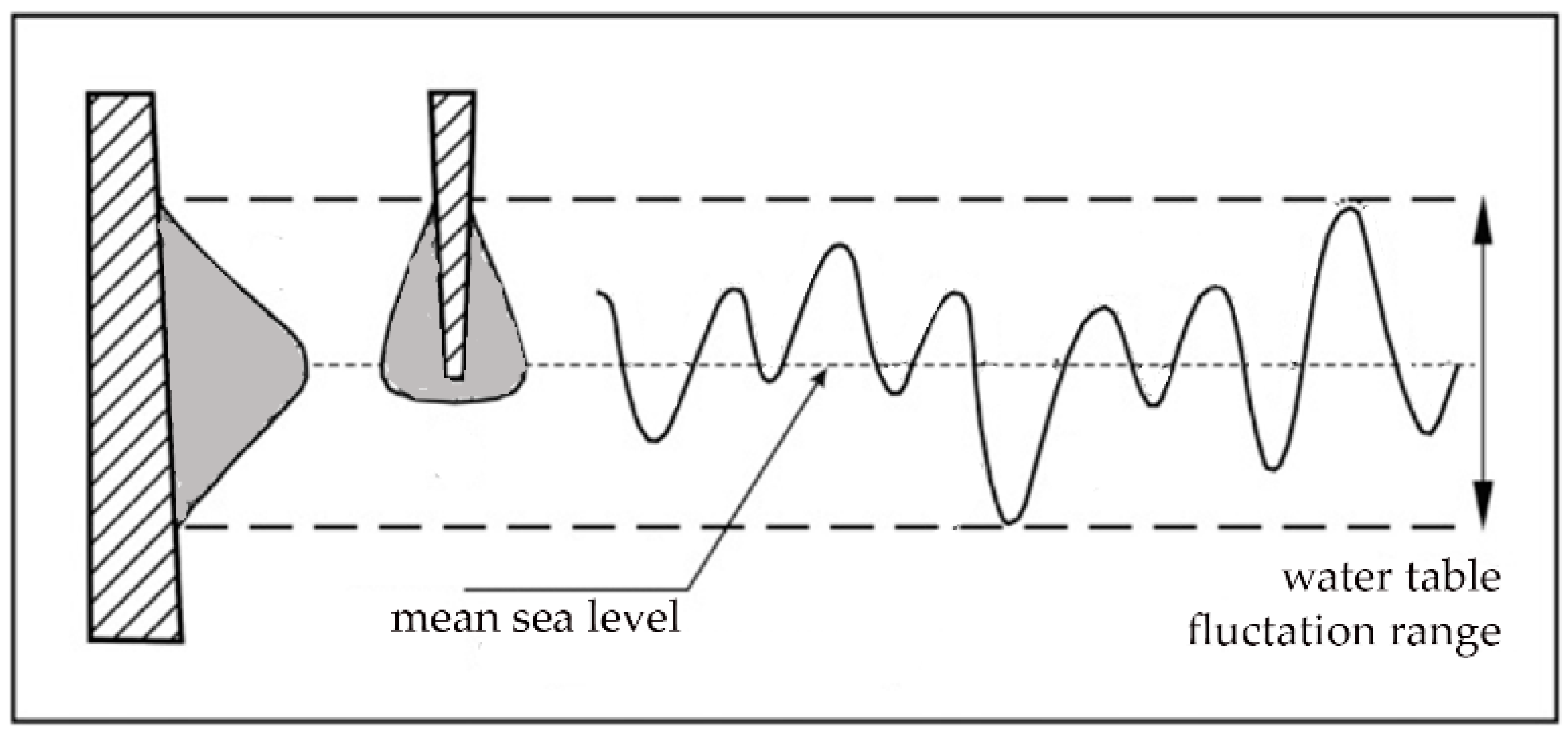
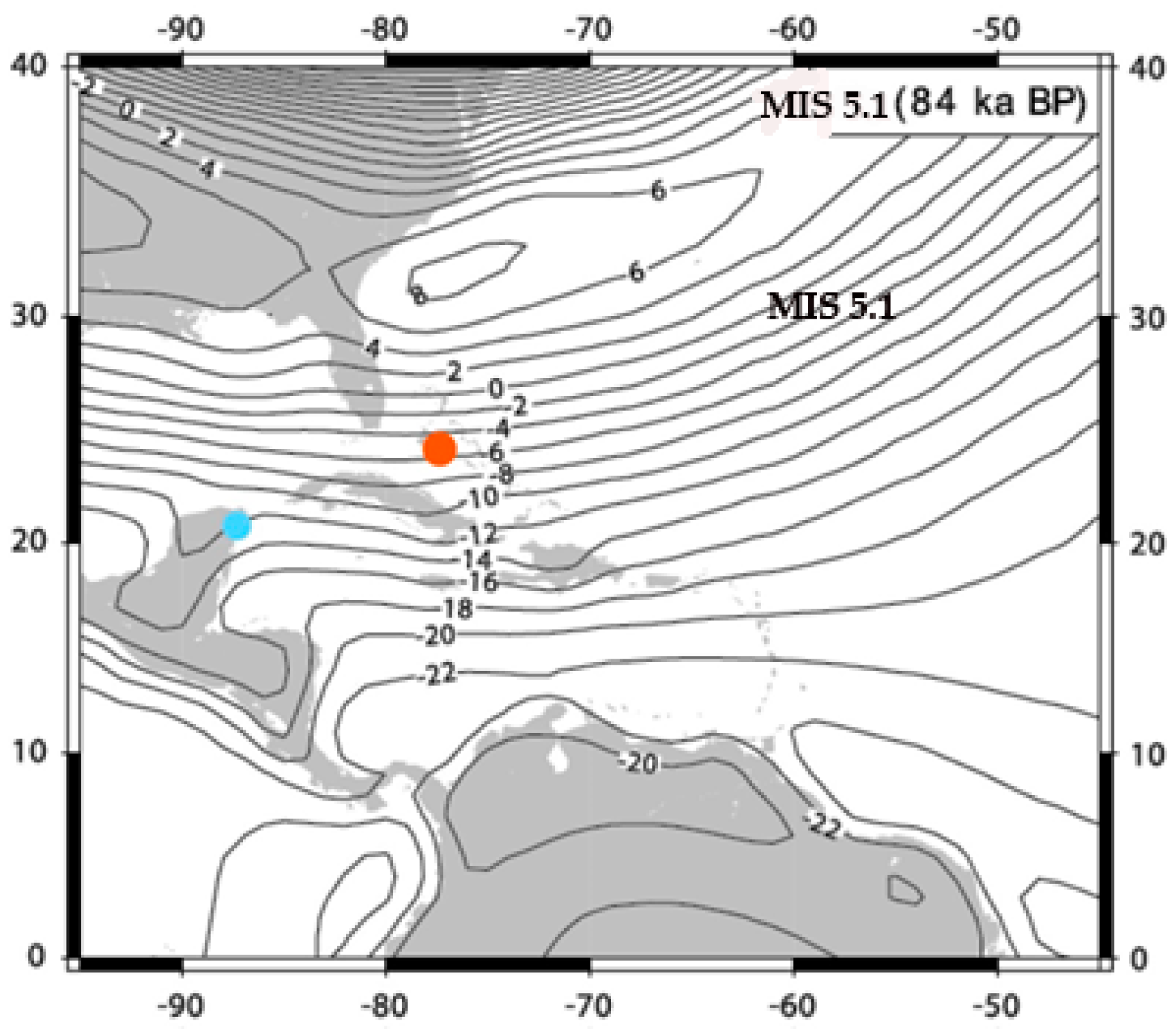
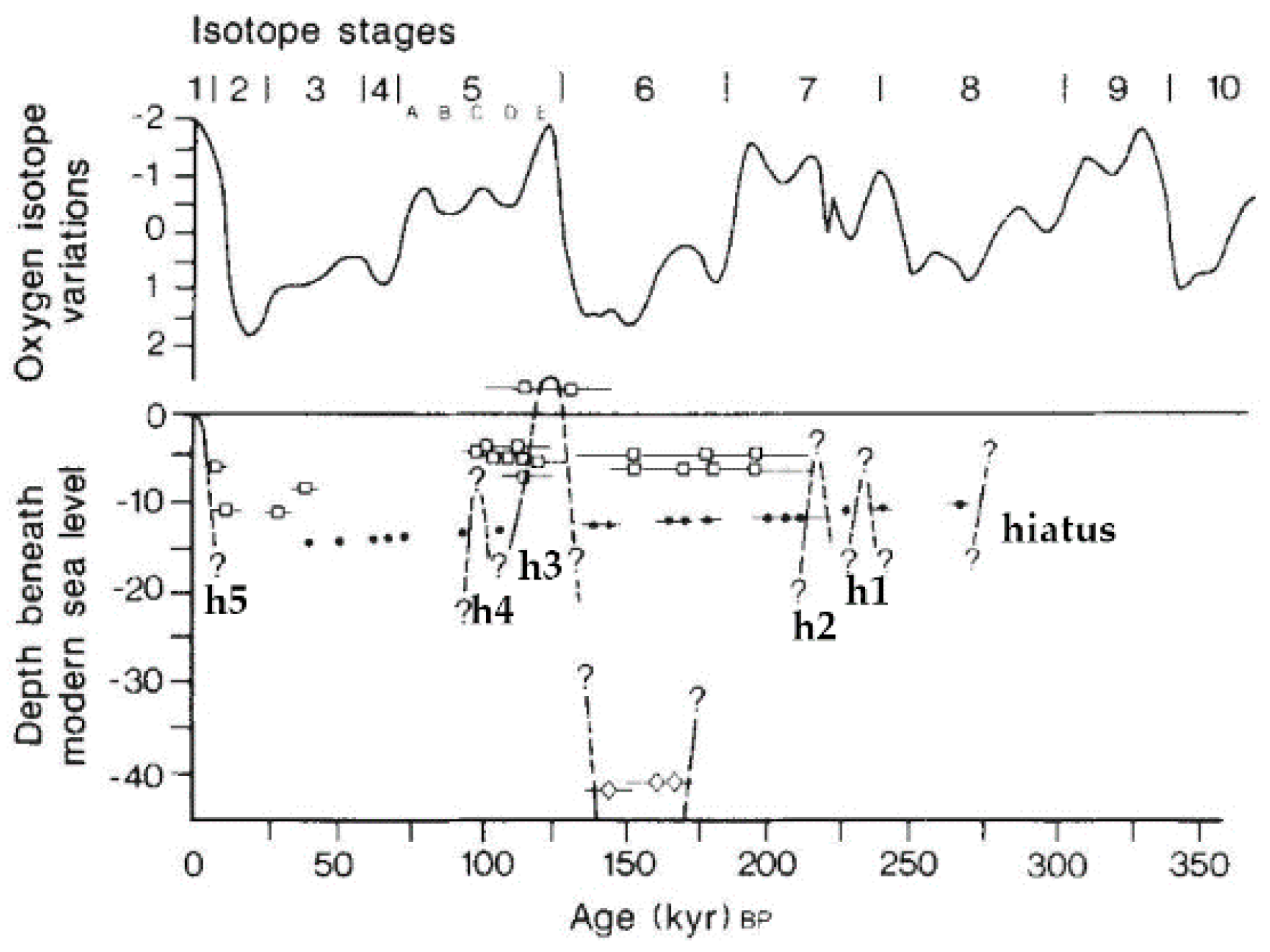
| Sample | U conc. | 234U/238U | 230Th/234U | 230Th/232Th | Age uncor. | −2 | 2 | Age re-calculated | Age cor. |
|---|---|---|---|---|---|---|---|---|---|
| (ppm) | Act. | At. | Act. | (kyr) | (kyr) | (kyr) | (kyr) | (kyr) | |
| 1 | 0.14 | 1.07 | 0.85 | 200 | 196.9 | 7 | 7 | 197.9 | 197.6 |
| 2 | 0.13 | 1.07 | 0.82 | 362 | 177 | 9.4 | 11.1 | 180.2 | 180.0 |
| 4 | 0.12 | 1.06 | 0.79 | 1499 | 164.1 | 10 | 11.7 | 165.6 | 165.6 |
| 5 | 0.13 | 1.06 | 0.81 | 682 | 177 | 10 | 10.5 | 175.7 | 175.6 |
| 6 | 0.14 | 1.06 | 0.8 | 562 | 168.2 | 4.1 | 4.1 | 170.5 | 170.4 |
| 7 | 0.15 | 1.06 | 0.58 | 849 | 94.3 | 8.2 | 8.8 | 93.6 | 93.5 |
| 8/9 | 00.13 | 1.06 | 0.7 | 2202 | 129.5 | 4.4 | 4.4 | 129.0 | 128.9 |
| 10 | 0.13 | 1.06 | 0.74 | 1466 | 144.1 | 9.4 | 10.5 | 143.8 | 143.8 |
| 10r | 0.13 | 1.06 | 0.73 | 1635 | 138.9 | 10 | 10.5 | 139.9 | 139.9 |
| 11 | 0.21 | 1.07 | 0.84 | 67 | 188.7 | 5.3 | 4.7 | 191.7 | 190.7 |
| 12 | 0.28 | 1.07 | 0.72 | 64 | 133.6 | 2.3 | 2.3 | 135.7 | 134.8 |
| 13 | 0.16 | 1.06 | 0.58 | 196 | 92.6 | 2.6 | 2.3 | 93.6 | 93.3 |
| 14 | 0.15 | 1.06 | 0.48 | 1459 | 70.6 | 3.8 | 4.1 | 70.8 | 70.7 |
| 14r | 0.15 | 1.06 | 0.45 | 1395 | 64.5 | 4.4 | 4.4 | 64.8 | 64.7 |
| 15 | 0.19 | 1.06 | 0.45 | 1250 | 64.2 | 1.2 | 1.2 | 64.8 | 64.7 |
| 16 | 0.15 | 1.06 | 0.45 | 1236 | 64 | 5.3 | 5.6 | 64.8 | 64.7 |
| 17 | 0.08 | 1.02 | 0.38 | 799 | 51 | 5 | 5.1 | 52.0 | 52.0 |
| 18 | 0.12 | 1.05 | 0.3 | 237 | 39.1 | 1.4 | 1.4 | 38.8 | 38.7 |
| F | 0.16 | 1.06 | 0.74 | 1864 | 143 | 3.5 | 2.9 | 143.8 | 143.8 |
| G | 0.18 | 1.06 | 0.75 | 2484 | 145.9 | 4.7 | 4.7 | 147.8 | 147.8 |
| H | 0.2 | 1.06 | 0.75 | 2642 | 149 | 4.1 | 4.7 | 147.8 | 147.8 |
| I | 0.2 | 1.06 | 0.73 | 2461 | 140 | 5.9 | 5.3 | 139.9 | 139.9 |
| N | 0.21 | 1.06 | 0.89 | 228 | 226.2 | 8.2 | 8.2 | 228.5 | 228.2 |
| P | 0.26 | 1.05 | 0.9 | 1567 | 241.4 | 7 | 7 | 239.3 | 239.3 |
| Q | 0.34 | 1.06 | 0.9 | 854 | 236.7 | 11.7 | 14.1 | 237.3 | 237.2 |
| Qr | 0.34 | 1.05 | 0.93 | 963 | 269.5 | 21.1 | 25.8 | 271.6 | 271.5 |
| R | 0.38 | 1.05 | 0.97 | 133 | 328.1 | 18.8 | 23.4 | 337.5 | 337.0 |
| A1 | 0.09 | 1.05 | 0.86 | 1285 | 208.6 | 22.3 | 28.1 | 207.0 | 206.9 |
| T1 | 0.14 | 1.06 | 0.9 | 1573 | 239.1 | 19.9 | 23.4 | 237.3 | 237.3 |
| T2 | 0.14 | 1.06 | 0.89 | 1215 | 225 | 11.7 | 15.2 | 228.5 | 228.5 |
| T4 | 0.22 | 1.06 | 0.89 | 173 | 225 | 7 | 5.9 | 228.5 | 228.1 |
| T4r | 0.21 | 1.06 | 0.88 | 223 | 222.7 | 9.4 | 8.2 | 220.4 | 220.1 |
| B1 | 0.22 | 1.06 | 0.9 | 769 | 240.2 | 9.3 | 10.5 | 237.3 | 237.2 |
| B2 | 0.16 | 1.05 | 0.93 | 186 | 274.2 | 9.4 | 9.4 | 271.6 | 271.2 |
| Y | 0.25 | 1.04 | 0.64 | 278 | 108.4 | 2.9 | 3.2 | 110.4 | 110.2 |
References
- Li, W.X.; Lundberg, J.; Dickin, A.P.; Ford, D.C.; Schwarcz, H.P.; McNutt, R.; Williams, D. High-precision mass-spectrometric uranium-series dating of cave deposits and implications for palaeoclimate studies. Nature 1989, 339, 534–536. [Google Scholar] [CrossRef]
- Bard, E.; Antonioli, F.; Silenzi, S. Sea-level during the penultimate interglacial period based on a submerged stalagmite from Argentarola Cave (Italy). Earth Planet. Sci. Lett. 2002, 196, 135–146. [Google Scholar] [CrossRef]
- Surić, M.; Richards, D.A.; Hoffmann, D.L.; Tibljaš, D.; Juračić, M. Sea-level change during MIS 5a based on submerged speleothems from the eastern Adriatic Sea (Croatia). Mar. Geol. 2009, 262, 62–67. [Google Scholar] [CrossRef]
- Dorale, J.A.; Onac, B.P.; Fornós, J.J.; Ginés, J.; Ginés, A.; Tuccimei, P.; Peate, D.W. Sea-level highstand 81, 000 years ago in mallorca. Science 2010, 327, 860–863. [Google Scholar] [CrossRef]
- Polyak, V.J.; Onac, B.P.; Fornós, J.J.; Hay, C.; Asmerom, Y.; Dorale, J.A.; Ginés, J.; Tuccimei, P.; Ginés, A. A highly resolved record of relative sea level in the western Mediterranean Sea during the last interglacial period. Nat. Geosci. 2018, 11, 860–864. [Google Scholar] [CrossRef]
- Stocchi, P.; Antonioli, F.; Montagna, P.; Pepe, F.; Lo Presti, V.; Caruso, A.; Corradino, M.; Dardanelli, G.; Renda, P.; Frank, N.; et al. A stalactite record of four relative sea-level highstands during the Middle Pleistocene Transition. Quat. Sci. Rev. 2017, 173, 92–100. [Google Scholar] [CrossRef]
- Grund, A. Die Karsthydrographie: Studien aus Westbosnien. Geogr. Abhandungen 1903, 7, 1–200. [Google Scholar]
- Spalding, R.F.; Mathews, T.D. Stalagmites from caves in the Bahamas: Indicators of low sea level stand. Quat. Res. 1972, 2, 470–472. [Google Scholar] [CrossRef]
- Ginés, A.; Ginés, J. Consideraciones sobre los mecanismos de fosilización de la “Cova de Sa Bassa Blanca” y su paralelismo con formaciones marinas del Cuaternario. Bolletí la Soc. d’Història Nat. les Balear. 1974, 19, 11–28. [Google Scholar]
- Richards, D.A.; Smart, P.L.; Lawrence Edwards, R. Maximum sea levels for the last glacial period from U-series ages of submerged speleothems. Nature 1994, 367, 357–360. [Google Scholar] [CrossRef]
- Lundberg, J.; Ford, D.C. Late pleistocene sea level change in the Bahamas from mass spectrometric U-series dating of submerged speleothem. Quat. Sci. Rev. 1994, 13, 1–14. [Google Scholar] [CrossRef]
- Furlani, S.; Cucchi, F.; Biolchi, S. Late Holocene widening of Karst voids by marine processes in partially submerged coastal caves (Northeastern Adriatic Sea). Geogr. Fis. Din. Quat. 2012, 35, 129–140. [Google Scholar]
- Sunamura, T. Geomorphology of Rocky Coasts; John Wiley & Sons: Chichester, UK, 1992; ISBN 0471917753. [Google Scholar]
- Mylroie, J.E.; Carew, J.L. The flank margin model for dissolution cave development in carbonate platforms. Earth Surf. Process. Landforms 1990, 15, 413–424. [Google Scholar] [CrossRef]
- Iliffe, T.M. Anchialine Cave Biology. In The Natural History of Biospeleology; Camach, A.I., Ed.; Museo Nacional De Ciencias Naturales: Madrid, Spain, 1992; pp. 615–636. [Google Scholar]
- Amorosi, A.; Antonioli, F.; Bertini, A.; Marabini, S.; Mastronuzzi, G.; Montagna, P.; Negri, A.; Rossi, V.; Scarponi, D.; Taviani, M.; et al. The Middle-Upper Pleistocene Fronte Section (Taranto, Italy): An exceptionally preserved marine record of the Last Interglacial. Glob. Planet. Change 2014, 119, 23–38. [Google Scholar] [CrossRef]
- Peirano, A.; Morri, C.; Bianchi, C.N.; Rodolfo-Metalpa, R. Biomass, Carbonate standing stock and production of the mediterranean coral Cladocora caespitosa (L.). Facies 2001, 44, 75–80. [Google Scholar] [CrossRef]
- Aguirre, J.; Jiménez, A.P. Fossil analogues of present-day Cladocora caespitosa coral banks: Sedimentary setting, dwelling community, and taphonomy (Late Pliocene, W Mediterranean). Coral Reefs 1998, 17, 203–213. [Google Scholar] [CrossRef]
- Alessio, M.; Allegri, L.; Antonioli, F.; Belluomini, G.; Impronta, S.; Manfra, L.; Preite, M. La curva di risalita del Mare Tirreno negli ultimi 43 ka ricavata da datazioni su speleotemi sommersi e dati archeologici. Mem. Descr. Serv. Geol. Naz. 1994, 52, 261–276. [Google Scholar]
- Antonioli, F.; Silenzi, S.; Frisia, S. Tyrrhenian Holocene palaeoclimate trends from spelean serpulids. Quat. Sci. Rev. 2001, 20, 1661–1670. [Google Scholar] [CrossRef]
- Antonioli, F.; Bard, E.; Potter, E.K.; Silenzi, S.; Improta, S. 215-ka history of sea-level oscillations from marine and continental layers in Argentarola Cave speleothems (Italy). Glob. Planet. Change 2004, 43, 57–78. [Google Scholar] [CrossRef]
- Dutton, A.; Bard, E.; Antonioli, F.; Esat, T.M.; Lambeck, K.; McCulloch, M.T. Phasing and amplitude of sea-level and climate change during the penultimate interglacial. Nat. Geosci. 2009, 2, 355–359. [Google Scholar] [CrossRef]
- Surić, M.; Juračić, M.; Horvatinčić, N.; Krajcar Bronić, I. Late Pleistocene-Holocene sea-level rise and the pattern of coastal karst inundation: Records from submerged speleothems along the Eastern Adriatic Coast (Croatia). Mar. Geol. 2005, 214, 163–175. [Google Scholar] [CrossRef]
- Surić, M.; Jalžić, B.; Petricioli, P. Submerged Speleothemes—Expect the Unexpected. Examples from the Eastern Adriatic Coast (Croatia). Acta Carsologica 2007, 36, 389–396. [Google Scholar] [CrossRef]
- Surić, M.; Juračić, M. Late Pleistocene—Holocene environmental changes—Records from submerged speleothems along the Eastern Adriatic coast (Croatia). Geol. Croat. 2010, 63, 155–169. [Google Scholar] [CrossRef]
- Antonioli, F.; Oliverio, M. Holocene Sea-Level Rise Recorded by a Radiocarbon-Dated Mussel in a Submerged Speleothem beneath the Mediterranean Sea. Quat. Res. 1996, 45, 241–244. [Google Scholar] [CrossRef]
- Ginés, J.; Ginés, A.; Fornós, J.J.; Tuccimei, P.; Onac, B.; Gràcia, F. Phreatic overgrowth on speleothems (POS) from Mallorca, Spain: Updating forty years of research. In Mallorca: A Mediterranean Benchmark for Quaternary Studies, 18; Societat d’Història Natural de les. Balears: Palma, Spain, 2012; pp. 111–146. ISBN 978-84-7632-995-5. [Google Scholar]
- Vesica, P.L.; Tuccimei, P.; Turi, B.; Fornós, J.J.; Ginés, A.; Ginés, J. Late Pleistocene Paleoclimates and sea-level change in the Mediterranean as inferred from stable isotope and U-series studies of overgrowths on speleothems, Mallorca, Spain. Quat. Sci. Rev. 2000, 19, 865–879. [Google Scholar] [CrossRef]
- Tuccimei, P.; Soligo, M.; Ginés, J.; Ginés, A.; Fornós, J.; Kramers, J.; Villa, I.M. Constraining Holocene sea levels using U-Th ages of phreatic overgrowths on speleothems from coastal caves in Mallorca (Western Mediterranean). Earth Surf. Process. Landforms 2010, 35, 782–790. [Google Scholar] [CrossRef]
- Gascoyne, M.; Benjamin, G.J.; Schwarcz, H.P.; Ford, D.C. Sea-level lowering during the Illinoian glaciation: Evidence from a Bahama “blue hole”. Science 1979, 205, 806–808. [Google Scholar] [CrossRef]
- Harmon, R.S.; Land, L.S.; Mitterer, R.M.; Garrett, P.; Schwarcz, H.P.; Larson, G.J. Bermuda sea level during the last interglacial. Nature 1981, 289, 481–483. [Google Scholar] [CrossRef]
- Moseley, G.; Smart, P.L.; Richards, D.A.; Hoffmann, D.L. Speleothem constraints on marine isotope stage (MIS) 5 relative sea levels, Yucatan Peninsula, Mexico. J. Quat. Sci. 2013, 28, 293–300. [Google Scholar] [CrossRef]
- Moseley, G.E.; Richards, D.A.; Smart, P.L.; Standish, C.D.; Hoffmann, D.L.; ten Hove, H.; Vinn, O. Early–middle Holocene relative sea-level oscillation events recorded in a submerged speleothem from the Yucatán Peninsula, Mexico. Holocene 2015, 25, 1511–1521. [Google Scholar] [CrossRef]
- De Waele, J.; D’Angeli, I.M.; Bontognali, T.; Tuccimei, P.; Scholz, D.; Jochum, K.P.; Columbu, A.; Bernasconi, S.M.; Fornós, J.J.; Grau González, E.R.; et al. Speleothems in a north Cuban cave register sea-level changes and Pleistocene uplift rates. Earth Surf. Process. Landf. 2018, 43, 2313–2326. [Google Scholar] [CrossRef]
- Van Hengstum, P.J.; Richards, D.A.; Onac, B.P.; Dorale, J.A. Coastal caves and sinkholes. In Handbook of Sea-Level Research; John Wiley & Sons, Ltd.: Chichester, UK, 2015; pp. 83–103. [Google Scholar]
- Antonioli, F.; Ferranti, L.; Stocchi, P.; Deiana, G.; Lo Presti, V.; Furlani, S.; Marino, C.; Orru, P.; Scicchitano, G.; Trainito, E.; et al. Morphometry and elevation of the last interglacial tidal notches in tectonically stable coasts of the Mediterranean Sea. Earth-Sci. Rev. 2018, 185, 600–623. [Google Scholar]
- Muhs, D.R.; Simmons, K.R.; Schumann, R.R.; Schweig, E.S.; Rowe, M.P. Testing glacial isostatic adjustment models of last-interglacial sea level history in the Bahamas and Bermuda. Quat. Sci. Rev. 2020, 233, 106212. [Google Scholar] [CrossRef]
- Stocchi, P.; Vacchi, M.; Lorscheid, T.; de Boer, B.; Simms, A.R.; van de Wal, R.S.W.; Vermeersen, B.L.A.; Pappalardo, M.; Rovere, A. MIS 5e relative sea-level changes in the Mediterranean Sea: Contribution of isostatic disequilibrium. Quat. Sci. Rev. 2018, 185, 122–134. [Google Scholar] [CrossRef]
- Potter, E.K.; Lambeck, K. Reconciliation of sea-level observations in the Western North Atlantic during the last glacial cycle. Earth Planet. Sci. Lett. 2004, 217, 171–181. [Google Scholar] [CrossRef]
- Chen, J.H.; Lawrence Edwards, R.; Wasserburg, G.J. 238U, 234U and 232Th in seawater. Earth Planet. Sci. Lett. 1986, 80, 241–251. [Google Scholar] [CrossRef]
- Lawrence Edwards, R.; Chen, J.H.; Wasserburg, G.J. 238U234U230Th232Th systematics and the precise measurement of time over the past 500,000 years. Earth Planet. Sci. Lett. 1987, 81, 175–192. [Google Scholar] [CrossRef]
- Bard, E.; Hamelin, B.; Fairbanks, R.G.; Zindler, A.; Mathieu, G.; Arnold, M. U-Th and 14C ages of corals from Barbados and their use for calibrating the 14C time scale beyond 9000 years B.P. Nucl. Inst. Methods Phys. Res. B 1990, 52, 461–468. [Google Scholar] [CrossRef]
- Bard, E.; Hamelin, B.; Arnold, M.; Montaggioni, L.; Cabioch, G.; Faure, G.; Rougerie, F. Deglacial sea-level record from Tahiti corals and the timing of global meltwater discharge. Nature 1996, 382, 241–244. [Google Scholar] [CrossRef]
- Genty, D.; Massault, M.; Gilmour, M.; Baker, A.; Verheyden, S.; Kepens, E. Calculation of past dead carbon proportion and variability by the comparison of AMS 14C and TIMS U-Th ages on two Holocene stalagmites. Radiocarbon 1999, 41, 251–270. [Google Scholar] [CrossRef]
- Tuccimei, P.; van Strydonck, M.; Ginés, A.; Ginés, J.; Soligo, M.; Villa, I.M.; Fornós, J.J. Comparison of 14C and U-Th ages of two holocene phreatic overgrowths on speleothems from Mallorca (Western mediterranean): Environmental implications. Int. J. Speleol. 2011, 40, 1–8. [Google Scholar] [CrossRef]
- Woodward, J. The Physical Geography of the Mediterranean; Oxford University Press: Oxford, UK, 2009; ISBN 9780199268030. [Google Scholar]
- Furlani, S.; Pappalardo, M.; Gómez-Pujol, L.; Chelli, A. The rock coast of the Mediterranean and Black seas. Geol. Soc. Mem. 2014, 40, 89–123. [Google Scholar] [CrossRef]
- Benjamin, J.; Rovere, A.; Fontana, A.; Furlani, S.; Vacchi, M.; Inglis, R.H.; Galili, E.; Antonioli, F.; Sivan, D.; Miko, S.; et al. Late Quaternary sea-level changes and early human societies in the central and eastern Mediterranean Basin: An interdisciplinary review. Quat. Int. 2017, 449, 29–57. [Google Scholar] [CrossRef]
- Mather, A. Tectonic Setting and Landscape Development. In The Physical Geography of the Mediterranean; Oxford University Press: Oxford, UK, 2009. [Google Scholar]
- Anzidei, M.; Lambeck, K.; Antonioli, F.; Furlani, S.; Mastronuzzi, G.; Serpelloni, E.; Vannucci, G. Coastal structure, sea-level changes and vertical motion of the land in the mediterranean. Geol. Soc. Spec. Publ. 2014, 388, 453–479. [Google Scholar] [CrossRef]
- Rohling, E.J.; Abu-Zied, R.; Casford, C.S.L.; Hayes, A.; Hoogakker, B.A.A. The Mediterranean Sea: Present and Past. In Physical Geography of the Mediterranean Basin; Oxford University Press: Oxford, UK, 2009; ISBN 978-0-19-926803-0. [Google Scholar]
- Millot, C.; Taupier-Letage, I. Circulation in the Mediterranean Sea. In Handbook of Environmental Chemistry; Saliot, A., Ed.; Springer: Heidelberg, Germany, 2005. [Google Scholar]
- Farrell, W.E.; Clark, J.A. On Postglacial Sea Level. Geophys. J. R. Astron. Soc. 2007, 46, 647–667. [Google Scholar] [CrossRef]
- Spada, G.; Stocchi, P. SELEN: A Fortran 90 program for solving the “sea-level equation”. Comput. Geosci. 2007, 33, 538–562. [Google Scholar] [CrossRef]
- Woodward, R.S. On the Form and Position of the Sea Level with Special References to Its Dependence on Superficial Masses Symmetrically Disposed about a Normal to the Earth’s Surface; Bulletin of the United States Geological Survey, 48; Government Printing Office: WA, USA, 1888. [CrossRef]
- Peltier, W.R. Global glacial isostasy and the surface of the ice-age Earth: The ICE-5G (VM2) model and GRACE. Annu. Rev. Earth Planet. Sci. 2004, 32, 111–149. [Google Scholar] [CrossRef]
- Stocchi, P.; Spada, G. Influence of glacial isostatic adjustment upon current sea level variations in the Mediterranean. Tectonophysics 2009, 474, 56–68. [Google Scholar] [CrossRef]
- Lisiecki, L.E.; Raymo, M.E. A Pliocene-Pleistocene stack of 57 globally distributed benthic δ18O records. Paleoceanography 2005, 20, 1–17. [Google Scholar] [CrossRef]
- Argus, D.F.; Peltier, W.R.; Drummond, R.; Moore, A.W. The Antarctica component of postglacial rebound model ICE-6G_C (VM5a) based on GPS positioning, exposure age dating of ice thicknesses, and relative sea level histories. Geophys. J. Int. 2014, 198, 537–563. [Google Scholar] [CrossRef]
- de Boer, B.; Stocchi, P.; Whitehouse, P.L.; van de Wal, R.S.W. Current state and future perspectives on coupled ice-sheet – sea-level modelling. Quat. Sci. Rev. 2017, 169, 13–28. [Google Scholar] [CrossRef]
- de Boer, B.; Stocchi, P.; van de Wal, R.S.W. A fully coupled 3-D ice-sheet–sea-level model: Algorithm and applications. Geosci. Model Dev. 2014, 7, 2141–2156. [Google Scholar] [CrossRef]
- Lucia, G.; Polyak, V.J.; Ginés, J.; Fornòs, J.J.; Ginés, A.; Asmerom, Y.; Onac, B.P. Chronology of Middle Pleistocene Coastal Karst Evolution and Relative Sea-Level Changes in Mallorca. J. Coast. Res. 2020, in press. [Google Scholar] [CrossRef]
- Alessio, M.; Allegri, L.; Antonioli, F.; Belluomini, G.; Ferranti, L.; Improta, S.; Manfra, L.; Proposito, A. Risultati preliminari relativi alla datazione di speleotemi sommersi nelle fasce costiere del Tirreno centrale. G. Geol. 1992, 54, 165–194. [Google Scholar]
- Dutton, A.; Scicchitano, G.; Monaco, C.; Desmarchelier, J.M.; Antonioli, F.; Lambeck, K.; Esat, T.M.; Fifield, L.K.; McCulloch, M.T.; Mortimer, G. Uplift rates defined by U-series and 14C ages of serpulid-encrusted speleothems from submerged caves near Siracusa, Sicily (Italy). Quat. Geochronol. 2009, 4, 2–10. [Google Scholar] [CrossRef]
- Furlani, S.; Antonioli, F.; Gambin, T.; Biolchi, S.; Formosa, S.; Lo Presti, V.; Mantovani, M.; Anzidei, M.; Calcagnile, L.; Quarta, G. Submerged speleothem in Malta indicates tectonic stability throughout the Holocene. Holocene 2018, 28, 1588–1597. [Google Scholar] [CrossRef]
- Surić, M.; Lončarić, R.; Lončar, N. Submerged caves of Croatia: Distribution, classification and origin. Environ. Earth Sci. 2010, 61, 1473–1480. [Google Scholar] [CrossRef]
- Pannacciulli, F.G.; Relini, G. The vertical distribution of Chthamalus montagui and Chthamalus stellatus (Crustacea, Cirripedia) in two areas of the NW Mediterranean Sea. Hydrobiologia 2000, 426, 105–112. [Google Scholar] [CrossRef]
- Reimer, P.J.; Austin, W.E.N.; Bard, E.; Bayliss, A.; Blackwell, P.G.; Bronk Ramsey, C.; Butzin, M.; Cheng, H.; Edwards, R.L.; Friedrich, M.; et al. The IntCal20 Northern Hemisphere Radiocarbon Age Calibration Curve (0-55 cal kBP). Radiocarbon 2020, 62, 725–757. [Google Scholar] [CrossRef]
- Stuiver, M.; Reimer, P.J.; Reimer, R.W. CALIB Radiocarbon Calibration, Version 7.10. Available online: http://calib.org/calib/ (accessed on 28 July 2016).
- Pons-Branchu, E.; Douville, E.; Roy-Barman, M.; Dumont, E.; Branchu, P.; Thil, F.; Frank, N.; Bordier, L.; Borst, W. A geochemical perspective on Parisian urban history based on U-Th dating, laminae counting and yttrium and REE concentrations of recent carbonates in underground aqueducts. Quat. Geochronol. 2014, 24, 44–53. [Google Scholar] [CrossRef]
- Ludwig, K.R.; Titterington, D.M. Calculation of 230Th-U isochrons, ages, and errors. Geochim. Cosmochim. Acta 1994, 58, 5031–5042. [Google Scholar] [CrossRef]
- Cheng, H.; Lawrence Edwards, R.; Shen, C.C.; Polyak, V.J.; Asmerom, Y.; Woodhead, J.; Hellstrom, J.; Wang, Y.; Kong, X.; Spötl, C.; et al. Improvements in 230Th dating, 230Th and 234U half-life values, and U-Th isotopic measurements by multi-collector inductively coupled plasma mass spectrometry. Earth Planet. Sci. Lett. 2013, 371–372, 82–91. [Google Scholar] [CrossRef]
- Jaffey, A.H.; Flynn, K.F.; Glendenin, L.E.; Bentley, W.C.; Essling, A.M. Precision measurement of half-lives and specific activities of U235 and U238. Phys. Rev. C 1971, 4, 1889–1906. [Google Scholar] [CrossRef]
- Hans Wedepohl, K. The composition of the continental crust. Geochim. Cosmochim. Acta 1995, 59, 1217–1232. [Google Scholar] [CrossRef]
- Richards, D.A.; Dorale, J.A. Uranium-series chronology and environmental applications of speleothems. Rev. Miner. Geochem. 2003, 52, 407–460. [Google Scholar] [CrossRef]
- Fornós, J.J.; Gelabert, B.; Ginés, A.; Ginés, J.; Tuccimei, P.; Vesica, P. Phreatic overgrowths on speleothems: A useful tool in structural geology in littoral karstic landscapes. the example of eastern mallorca (balearic islands). Geodin. Acta 2002, 15, 113–125. [Google Scholar] [CrossRef]
- Surić, M.; Juračić, M. Late Pleistocene–Holocene palaeoenvironmental changes—Records from submerged speleothems from the Eastern Adriatic Sea (Croatia). In Proceedings of the International interdisciplinary scientific conference Sustainability of Karst Environment Dinaric Karst and other Karst Regions, Zagreb, Croatia, 23–26 September 2009. [Google Scholar]
- Lambeck, K.; Antonioli, F.; Anzidei, M.; Ferranti, L.; Leoni, G.; Scicchitano, G.; Silenzi, S. Sea level change along the Italian coast during the Holocene and projections for the future. Quat. Int. 2011, 232, 250–257. [Google Scholar] [CrossRef]
- Antonioli, F.; Cremona, G.; Immordino, F.; Puglisi, C.; Romagnoli, C.; Silenzi, S.; Valpreda, E.; Verrubbi, V. New data on the Holocenic sea-level rise in NW Sicily (Central Mediterranean Sea). Glob. Planet. Chang. 2002, 34, 121–140. [Google Scholar] [CrossRef]
- Lambeck, K.; Antonioli, F.; Purcell, A.; Silenzi, S. Sea-level change along the Italian coast for the past 10,000 yr. Quat. Sci. Rev. 2004, 23, 1567–1598. [Google Scholar] [CrossRef]
- Antonioli, F.; Mucedda, M.; Silenzi, S.; Verrubbi, V. Seal level and hydrological conditions during MIS 6.5 from a submerged speleothem sampled at −52 m in Sardinia (Italy). In Proceedings of the Karst 3 Congress, Montpellier, France, 20–24 April 2003; Abstract Volume, pp. 18–24. [Google Scholar]
- Tuccimei, P.; Antonioli, F.; Delitala, M.C.; Fornós, J.J.; Ginés, A.; Ginés, J.; Mucedda, M.; Orrù, P.; Taddeucci, A. Sea level changes during Oxygen Isotope Stage 5 at Capo Caccia (Alghero, Sardinia), based on U-Th datings of phreatic overgrowths on speleothems and geomorphological evidences. In Proceedings of the “L’Eemiano e il Tirreniano in Italia”, Verona, Italy, 12–13 September 2000; pp. 24–26. [Google Scholar]
- Tuccimei, P.; Fornós, J.J.; Ginés, J.; Ginés, A.; Gràcia, F.; Mucedda, M. Sea level change at Capo Caccia (NW Sardinia) and Mallorca (Balearic Islands) during oxygen isotope substage 5e, based on Th/U datings of phreatic overgrowths on speleothems. In Proceedings of the Geomorfologia litoral i Quaternari. Homenatge a Joan Cuerda Barceló; Pons, G.X., Vicens, D., Eds.; SHNB Societat d’Història Natural de les Balears: Palma de Mallorca, Spain, 2007; pp. 121–135. [Google Scholar]
- Antonioli, F.; Ferranti, L.; Lo Schiavo, F. The submerged neolithic burials of the grotta Verde at Capo Caccia (Sardinia, Italy) implication for the Holocene sea level rise. Mem. Descr. Serv. Geol. Naz. 1996, 52, 290–312. [Google Scholar]
- Lorscheid, T.; Stocchi, P.; Casella, E.; Gómez-Pujol, L.; Vacchi, M.; Mann, T.; Rovere, A. Paleo sea-level changes and relative sea-level indicators: Precise measurements, indicative meaning and glacial isostatic adjustment perspectives from Mallorca (Western Mediterranean). Palaeogeogr. Palaeoclimatol. Palaeoecol. 2017, 473, 94–107. [Google Scholar] [CrossRef]
- Edwards, R.L.; Gallup, C.D.; Cheng, H. Uranium-series dating of marine and lacustrine carbonates. In Uranium-Series Geochemistry, Reviews in Mineralogy and Geochemistry; Mineralogical Socity of America: Chantilly, VA, USA, 2003; Volume 52, pp. 363–405. ISBN 9781501509308. [Google Scholar]
- Capotondi, L.; Vigliotti, L. Magnetic and microfaunal characterization of Late Quaternary sediments from the Western Mediterranean: Inferences about sapropel formation and Paleoceanographic implications. In Ocean Drilling Program: Scientific Results; Texas A and M University: College Station, TX, USA, 1999; Volume 161, pp. 505–518. [Google Scholar]
- Waelbroeck, C.; Labeyrie, L.; Michel, E.; Duplessy, J.C.; McManus, J.F.; Lambeck, K.; Balbon, E.; Labracherie, M. Sea-level and deep water temperature changes derived from benthic foraminifera isotopic records. Quat. Sci. Rev. 2002, 21, 295–305. [Google Scholar] [CrossRef]
- Surić, M.; Horvatinčić, N.; Suckow, A.; Juračić, M.; Barešić, J. Isotope records in submarine speleothems from the Adriatic coast, Croatia. Bull. Soc. Geol. Fr. 2005, 176, 363–373. [Google Scholar] [CrossRef]
- Surić, M.; Korbar, T.; Juračić, M. Tectonic constraints on the late Pleistocene-Holocene relative sea-level change along the north-eastern Adriatic coast (Croatia). Geomorphology 2014, 220, 93–103. [Google Scholar] [CrossRef]
- Lambeck, K.; Chappell, J. Sea level change through the last glacial cycle. Science 2001, 292, 679–686. [Google Scholar] [CrossRef] [PubMed]
- Florido, E.; Auriemma, R.; Faivre, S.; Radić Rossi, I.; Antonioli, F.; Furlani, S.; Spada, G. Istrian and Dalmatian fishtanks as sea-level markers. Quat. Int. 2011, 232, 105–113. [Google Scholar] [CrossRef]
- Radić Rossi, I.; Antonioli, F.; Spada, G.; Zubčić, K.; Meštrov, M. Sea level and shoreline changes in the Pakoštane area over the past six millennia. In The Late Roman Shipwreck in Its Geological-Geographical and Cultural-Historical Context; Radić Rossi, I., Boetto, G., Eds.; Institute for Maritime Heritage Ars Nautica, University of Zadar: Zadar, Croatia, 2018; pp. 205–224. [Google Scholar]
- Ferranti, L.; Antonioli, F.; Mauz, B.; Amorosi, A.; Dai Pra, G.; Mastronuzzi, G.; Monaco, C.; Orrù, P.; Pappalardo, M.; Radtke, U.; et al. Markers of the last interglacial sea-level high stand along the coast of Italy: Tectonic implications. Quat. Int. 2006, 145–146, 30–54. [Google Scholar] [CrossRef]
- Hearty, P.J.; Miller, G.H.; Stearns, C.E.; Szabo, B.J. Aminostratigraphy of Quaternary shorelines in the Mediterranean basin. Geol. Soc. Am. Bull. 1986, 97, 850–858. [Google Scholar] [CrossRef]
- Muhs, D.R.; Simmons, K.R.; Meco, J.; Porat, N. Uranium-series ages of fossil corals from Mallorca, Spain: The “Neotyrrhenian” high stand of the Mediterranean Sea revisited. Palaeogeogr. Palaeoclimatol. Palaeoecol. 2015, 438, 408–424. [Google Scholar] [CrossRef][Green Version]
- Siddall, M.; Rohling, E.J.; Almogi-Labin, A.; Hemleben, C.; Meischner, D.; Schmelzer, I.; Smeed, D.A. Sea-level fluctuations during the last glacial cycle. Nature 2003, 423, 853–858. [Google Scholar] [CrossRef]
- Rodríguez-Vidal, J.; Cáceres, L.M.; Finlayson, J.C.; Gracia, F.J.; Martínez-Aguirre, A. Neotectonics and shoreline history of the Rock of Gibraltar, southern Iberia. Quat. Sci. Rev. 2004, 23, 2017–2029. [Google Scholar] [CrossRef]
- Gowan, E.J.; Zhang, X.; Khosravi, S.; Rovere, A.; Stocchi, P.; Hughes, A.C.; Gyllencreutz, R.; Mangerud, J.; Svendsen, J.I.; Lohmann, G. Global ice sheet reconstruction for the past 80000 years. PANGEA 2019. in print. [Google Scholar] [CrossRef]
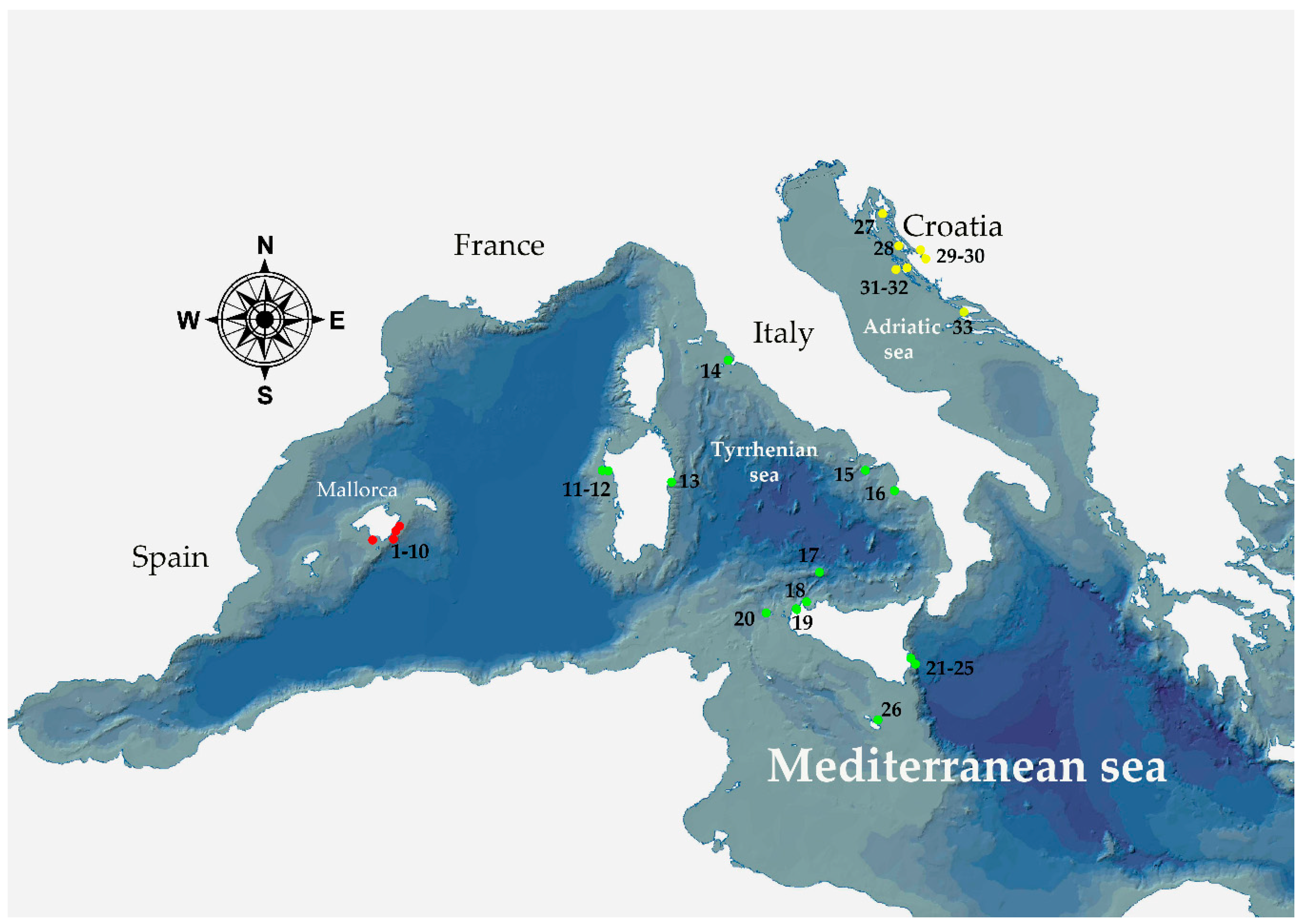
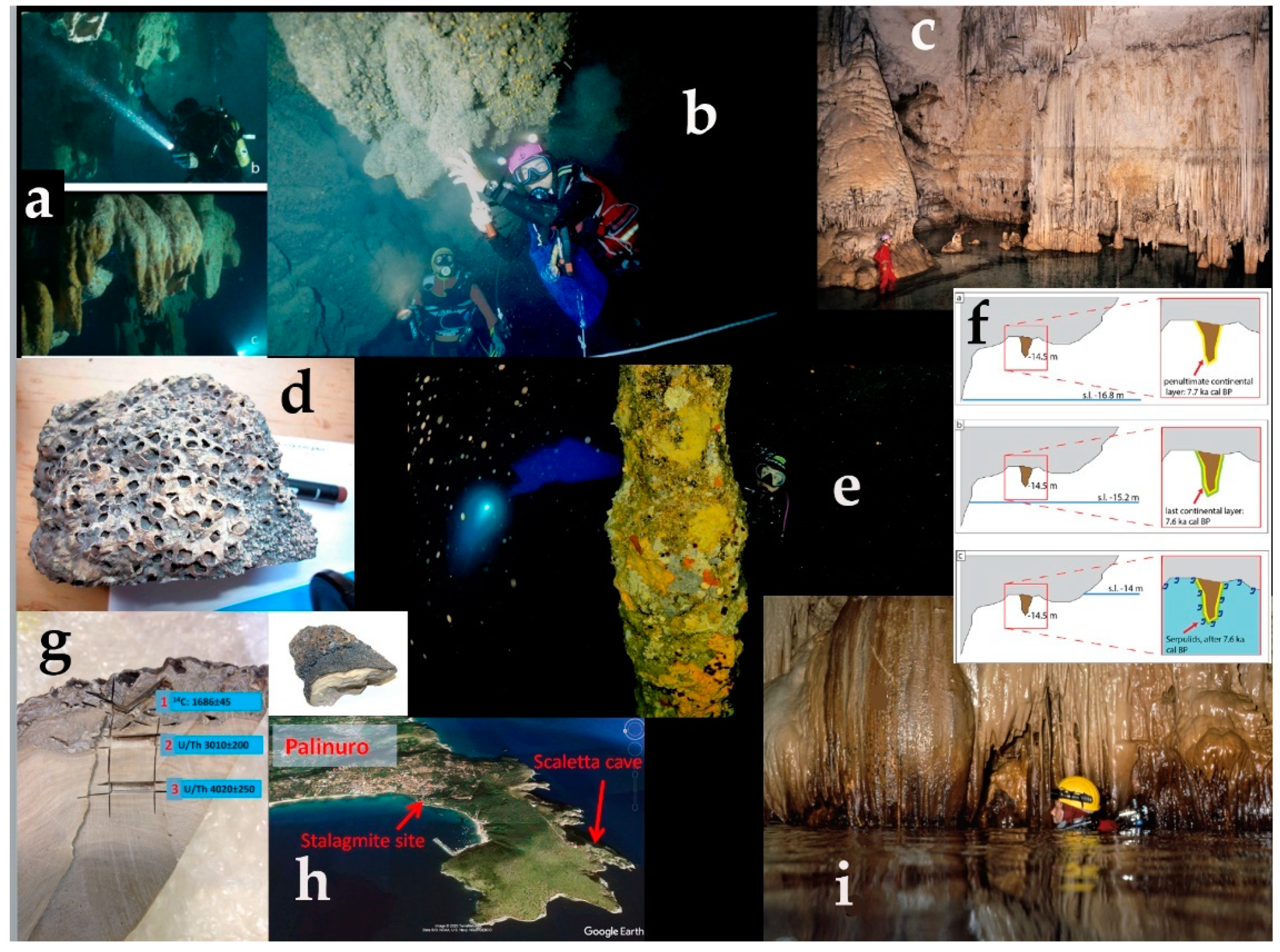
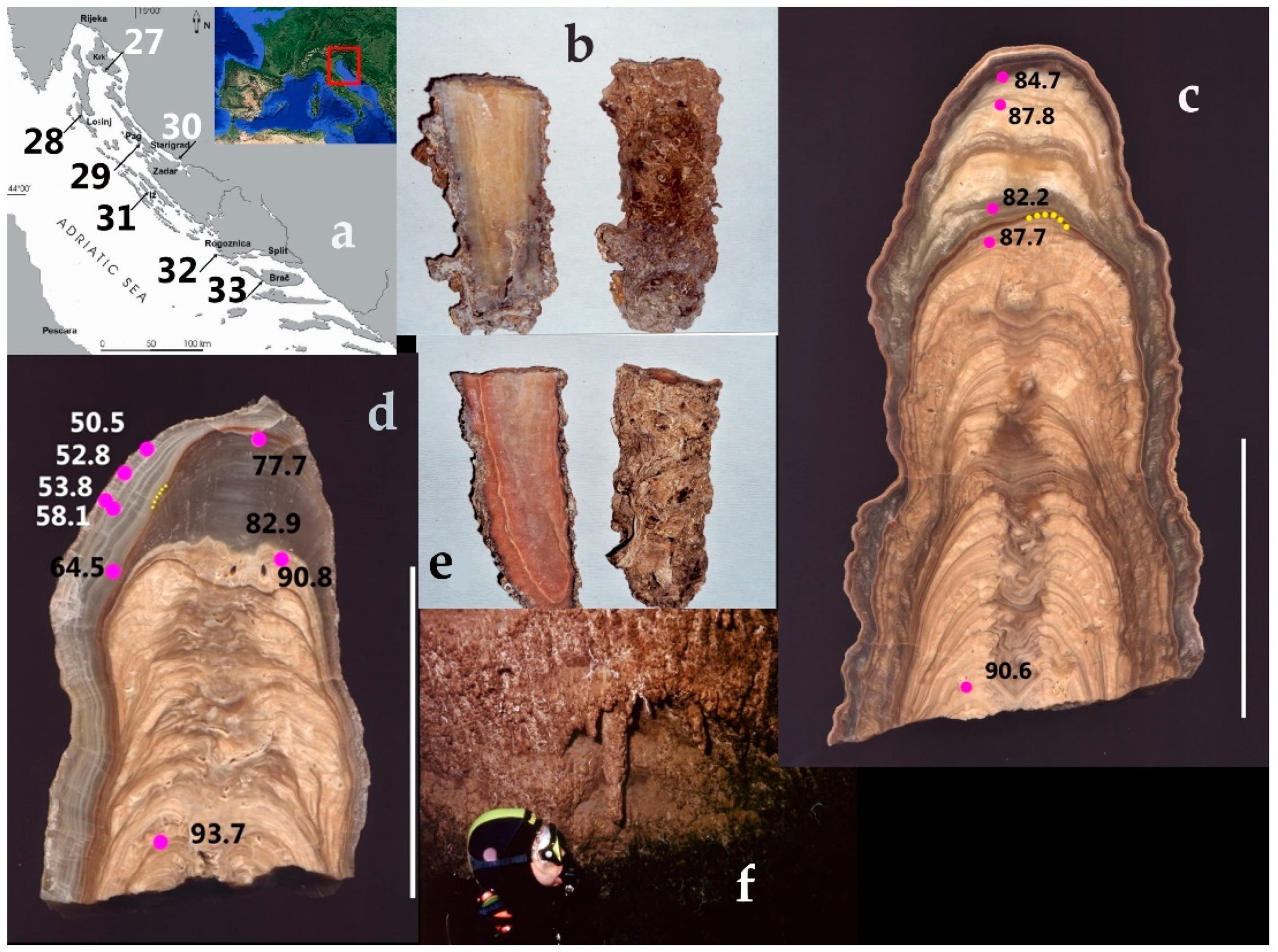
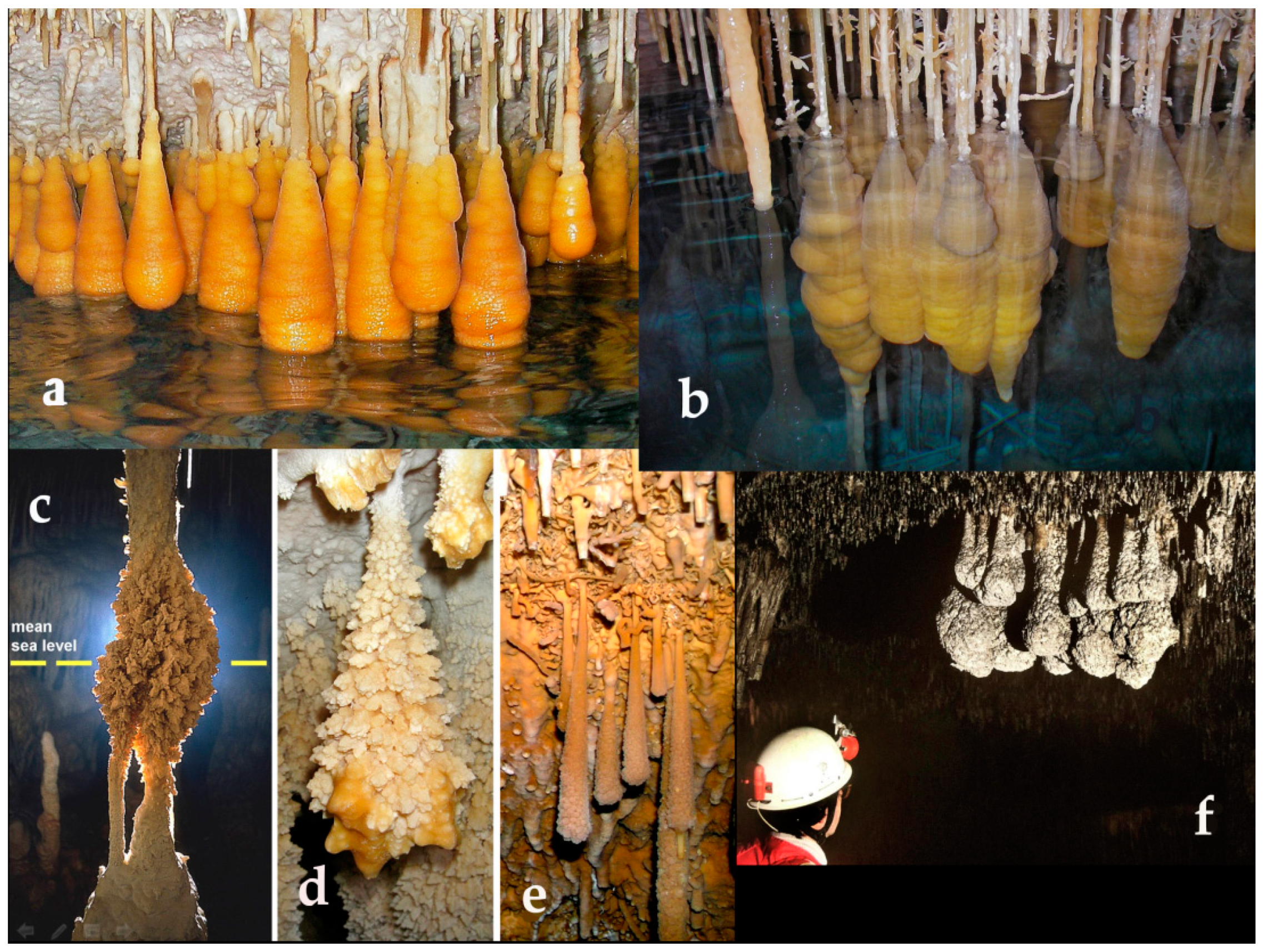
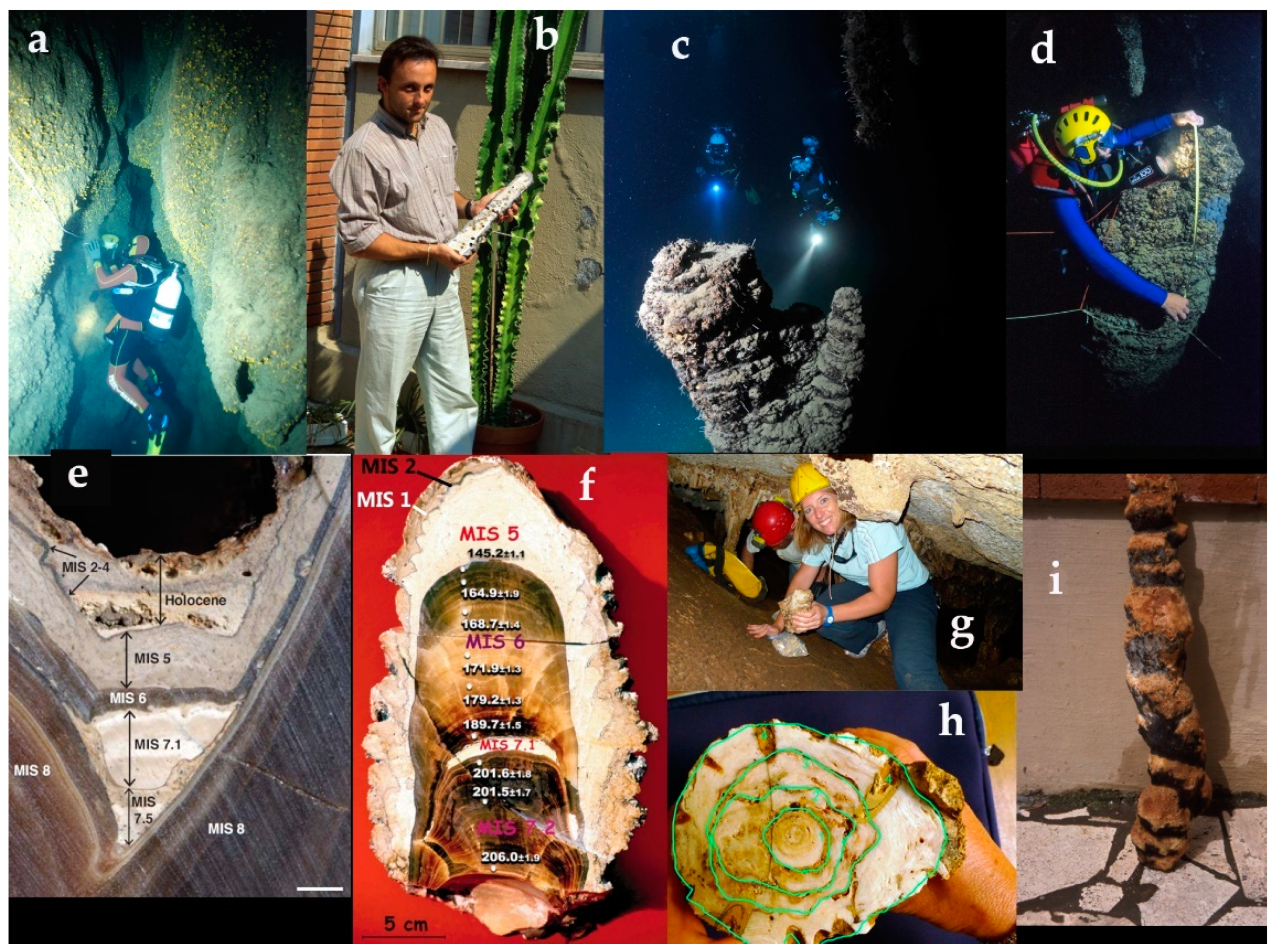
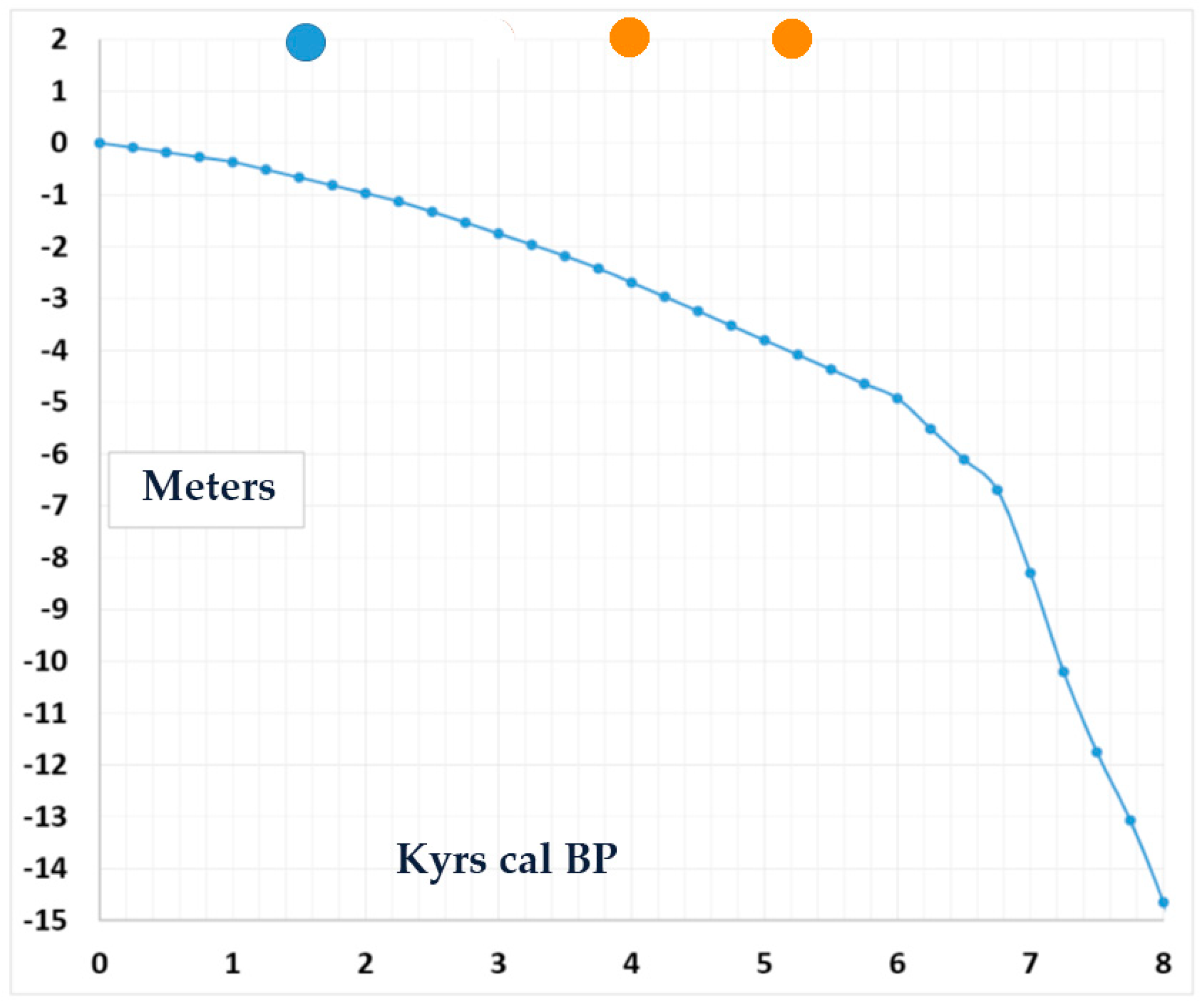
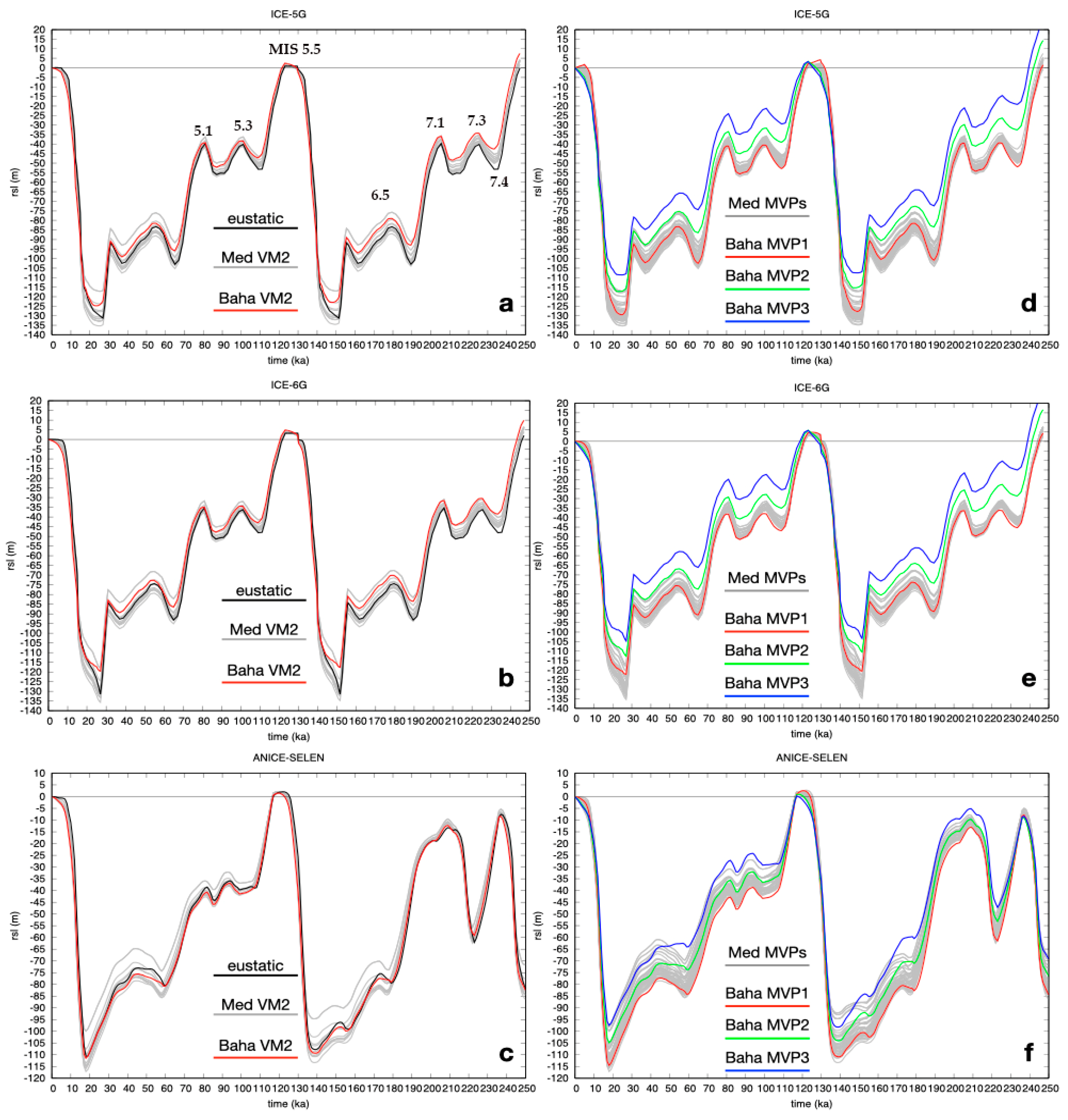
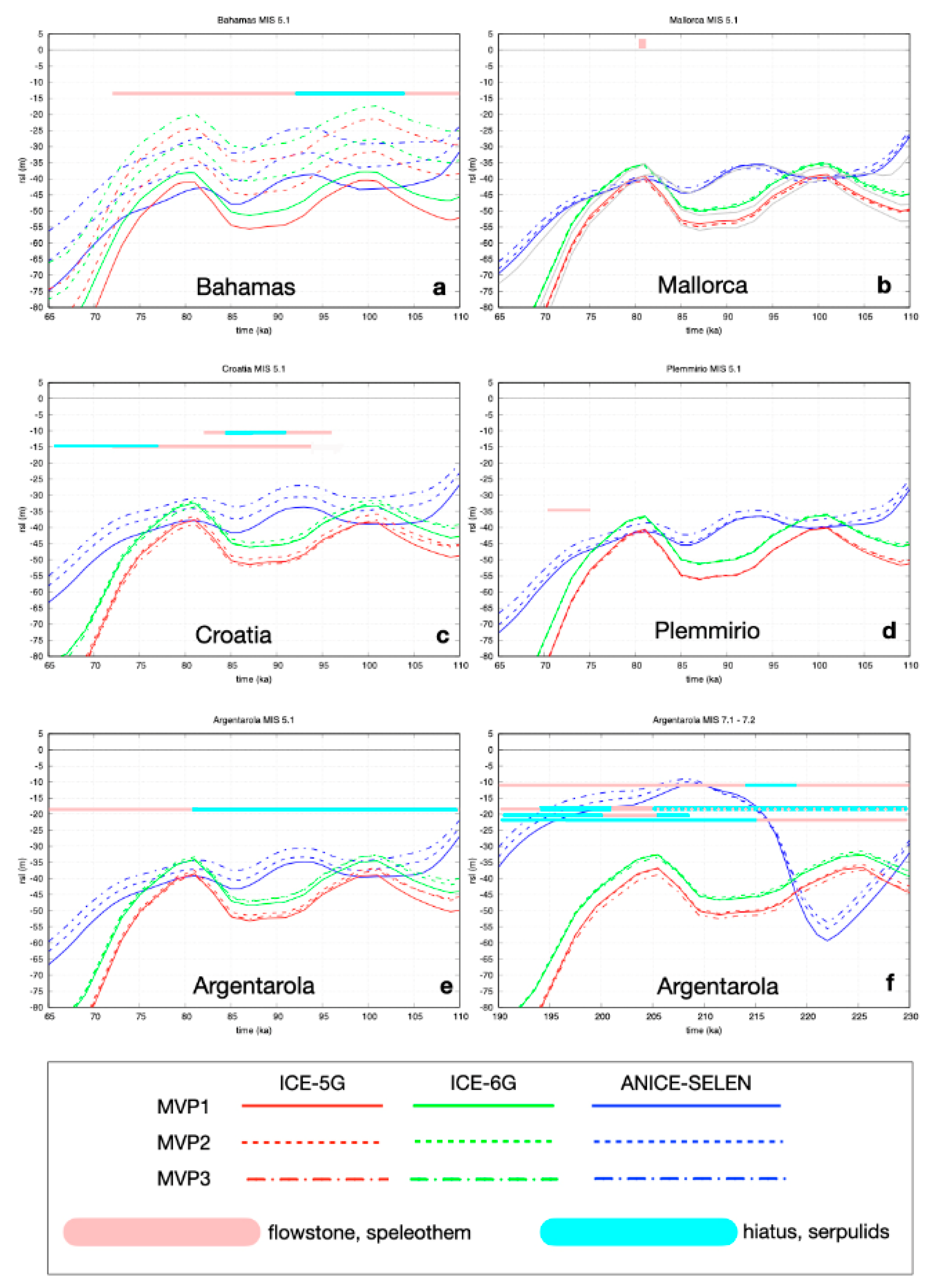

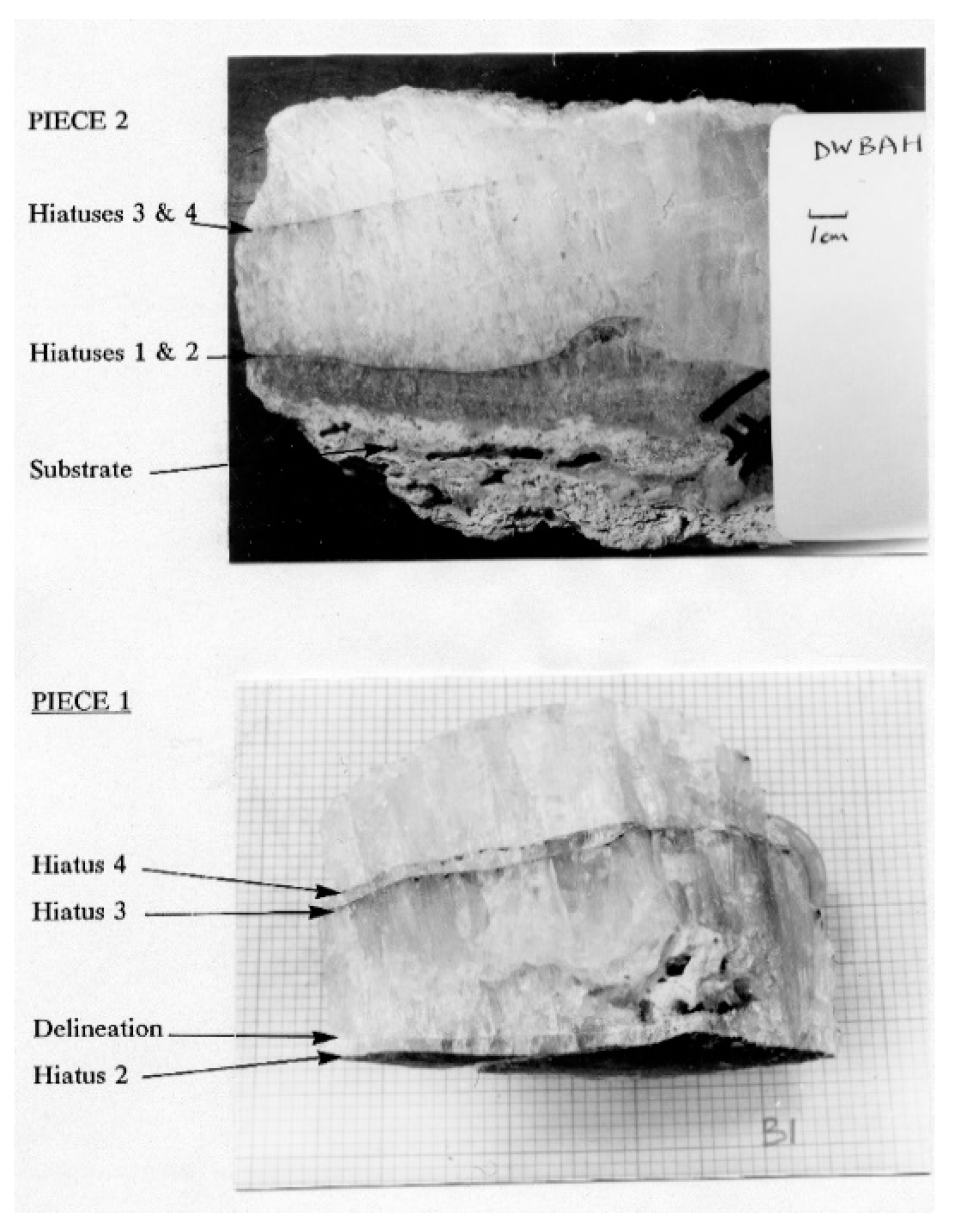
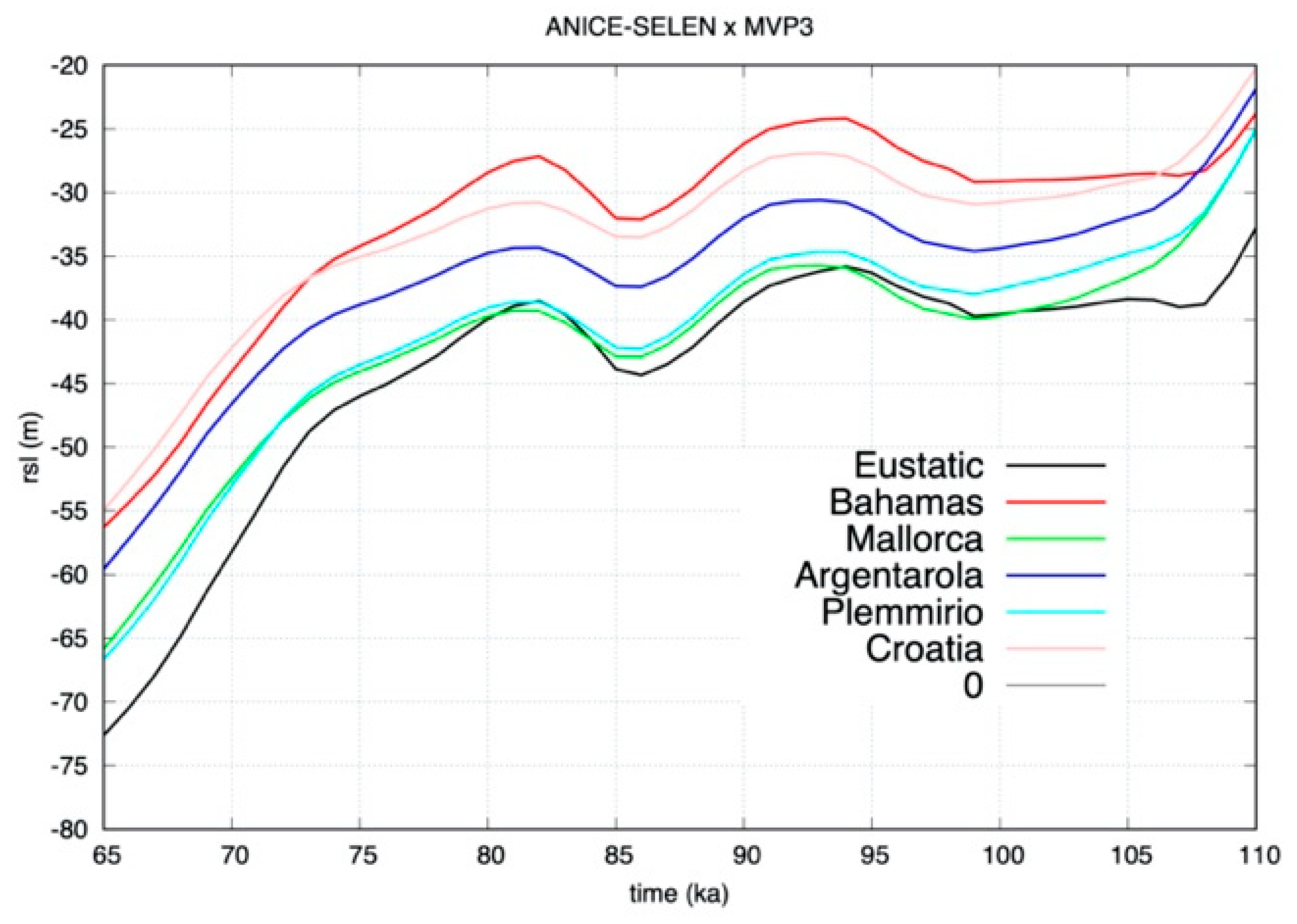


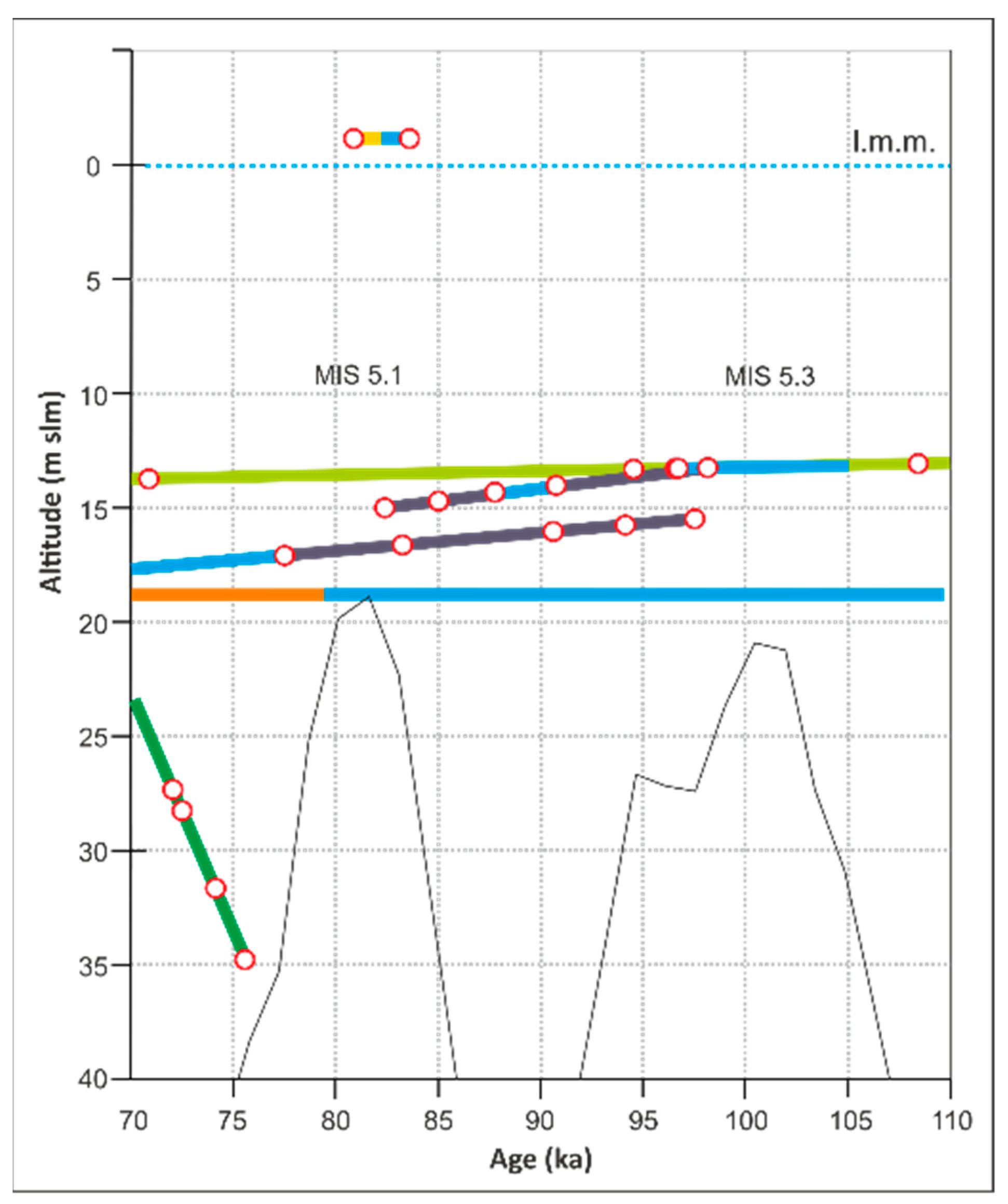
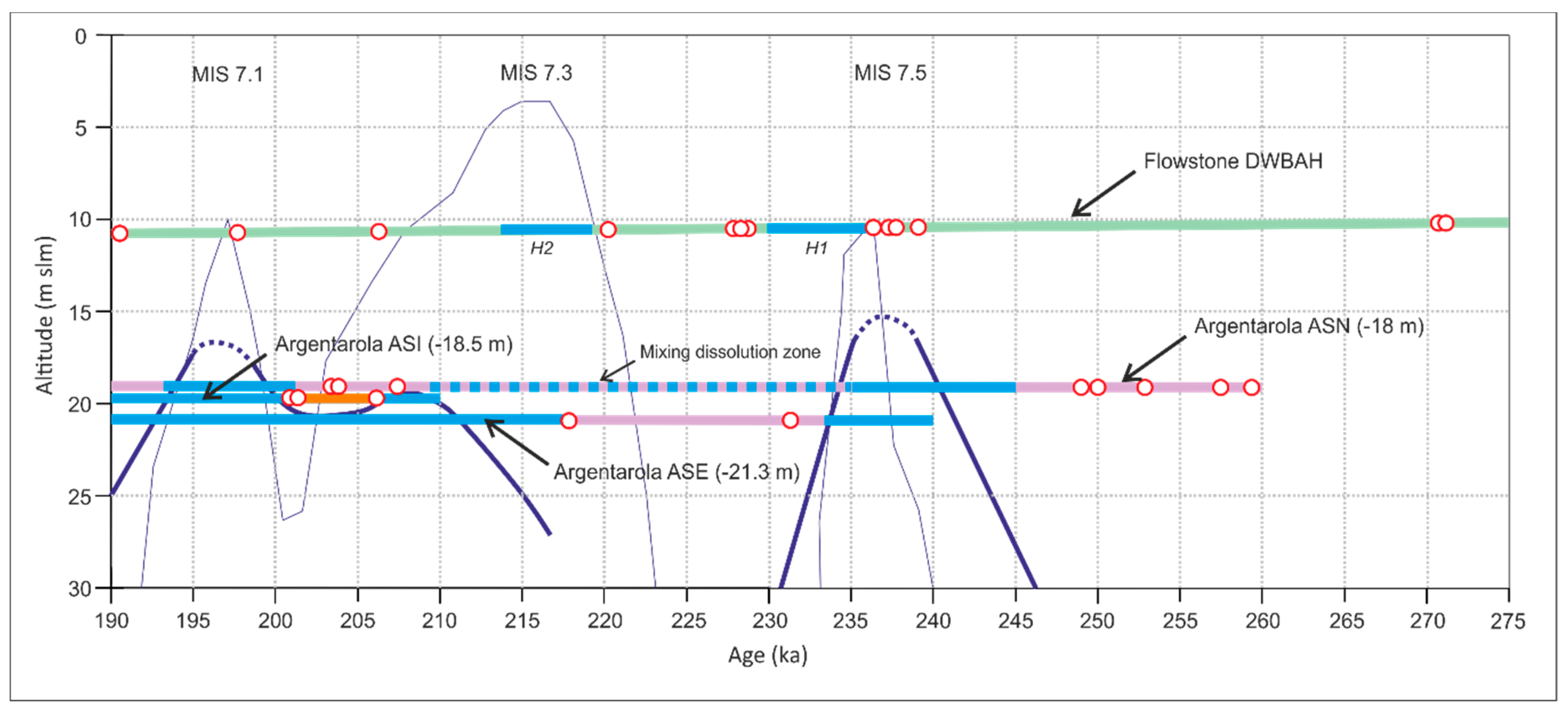
| VM2 | LT (km) | UM (×1021 Pa⋅s) | LUM (×1021 Pa⋅s) | TZ (×1021 Pa⋅s) | LM (×1021 Pa⋅s) |
|---|---|---|---|---|---|
| 90 | 0.67 | 0.44 | 0.46 | 2.53 |
| MVPs | LT (km) | UM (×1021 Pa⋅s) | TZ (×1021 Pa⋅s) | LM (×1021 Pa⋅s) |
|---|---|---|---|---|
| MVP1 | 100 | 1 | 1 | 2 |
| MVP2 | 100 | 0.5 | 0.5 | 5 |
| MVP3 | 100 | 0.25 | 0.5 | 10 |
| Submerged Cave | Coordinates (Lat, Long) | Lithology | Reference | Layer | Dating Method | Time Range (kyr cal BP) | Depth (m) |
|---|---|---|---|---|---|---|---|
| 1–10 Mallorca, Spain | Average (10 caves) | Mesozoic to | Vesica et al. (2000) | Continental; POS | U-Th | ||
| 1 Cova de Cala Falcò | Miocene calcarenites | (TIMS) | 83.9 | + 1.9 | |||
| 2 Cova de Cala Varques | 36.0, 83.4, 71.3, 119.9 | + 1.4 | |||||
| 3 Cova des Serral | 121.3 | + 1.5 | |||||
| 4 Cova de Dimoni | 39.49976 | 107.9, 112,9, 119.7 | + 2.5 | ||||
| 5 Coved del Pirata | 3.31629 | 130.4 | + 2.1 | ||||
| 6 Covas de na Barxa | 124.7 | + 2.4 | |||||
| 7 Cova de na Mitjana | 231.9, > 300 | + 4.9, + 5.8 | |||||
| 8 Cova del Drac | > 350 | + 3.3 | |||||
| 2 Cova de Cala Varques | - | Miocene calcarenites | Tuccimei et al. (2010) | Continental; POS | U-Th (MC-ICPMS) | 1.1–2.8 | |
| - | Miocene | Dorale et al. (2010) | Continental; POS | U-Th | mean +1.4 | ||
| 2 Cova Varques | calcarenites | (TIMS) | 80.12–81.95 (MIS 5.1) | +1.25–1.57 | |||
| 4 Cova Dimoni | +1.48–1.45 | ||||||
| 1 Cova Falcò | +1.53–1.57 | ||||||
| 9 Cova des Pas de Vallgonera | +1.52–1.6 | ||||||
| 1–9 Mallorca | - | Miocenecalcarenites | Polyak et al. (2018) | Continental; POS | U-Th (MC-ICPMS) | 116.0–126.6 (MIS 5.5) | mean +2.15 |
| 1 Cova Falcò | - | Miocene | Lucia et al. (2020) | Continental | U/Th | 465 | +2 |
| calcarenites | (MC-ICPMS) | 558 | +2.9 | ||||
| 643 | +2.8 | ||||||
| 500 | +3 | ||||||
| 4 Cova Dimoni | 948–482 | +5 | |||||
| 10 Sa Ferradura | 1084–587 | +3 | |||||
| 1355–588 | +5.5 | ||||||
| 1205–672 | +4.5 | ||||||
| 1460–702 | +3.5 | ||||||
| 11 Grotta di Nettuno, Sardinia, Italy 12 Eurhotel, Sardinia, Italy | 40.56463 8.16042 - | Mesozoic limestones | Antonioli and Mucedda (2003) Alessio et al. (1994) Alessio et al. (1994) | Continental Continental Continental | U-Th (alpha-counting) 14C | 165 ± 12 (MIS 6) 5.371 7.283 | −52 −1 −1 |
| 14C | |||||||
| 13 Risorgenza cala Luna, | 40.22420 | Mesozoic | Alessio et al. (1994) | Continental | 14C | 25.377 (MIS 2) | −9 |
| Orosei gulf, Sardinia, Italy | 9.62864 | limestones | |||||
| 14 Argentarola cave, Italy | 42.4181 | Upper Triassic | Antonioli et al. (2004) | Continental | U/Th | 6.5–9.6 | |
| 11.08142 | dolomitic | MOVR | (TIMS) | −3.5, −21.7 | |||
| limestone | |||||||
| 14 Argentarola, Grosseto, | 42.4181 | Upper Triassic | Bard et al. (2002) | Continental | U/Th | 145.2–189.7 (MIS 6) | −18.5 |
| Italy | 11.08142 | dolomitic | MOVR | (TIMS) | <201.6 (MIS 7.1) | ||
| ASI −18.5 | limestone | 201.6 (MIS 7.2) | |||||
| 14 Argentarola cave, | 42.4181 | Upper Triassic | Dutton et al. (2009a) | Continental | U/Th | 201.5–189.7 (MIS 7.1) | −18, −21.7 |
| Italy | 11.08142 | dolomitic | MOVR | (MC-ICPMS) | 217.2–206.0 (MIS 7.3) | ||
| ASN −18 m | limestone | (TIMS) | 248.9–231.0 (MIS 7.5) | ||||
| ASE −21.3 m | 35.2–48.4 (MIS 3) | ||||||
| 157.3–180.8 (MIS 6) | |||||||
| 203.3–207.1 (MIS 7.2) | |||||||
| 248.9–259.0 (MIS 8) | |||||||
| 183.1 (MIS 6) | |||||||
| 217.2–2131.0 (MIS 7.4) | |||||||
| 15 Capri, Italy | 40.55307 14.26406 | Jurassic- Cretaceous limestone | Alessio et al. (1994) | Continental | 14C | 3.92 | −3.5 |
| 16 Scaletta cave, Palinuro, 14 Argentarola cave, Italy | 40.02373 15.27159 | Mesozoic limestones | Alessio et al. (1992, 1994); Antonioli and Oliverio (1996) Alessio et al. (1992, 1994) | Continental MOVR | 14C | MIS 1-2 10.2 MIS 1-2 | −41, −27−48 16, −14, −12, −10, −4 |
| 17 Ustica, Italy | 38.70513 13.19478 | Pleistocene volcanic rocks | Alessio et al. (1994) | Continental | 14C | 3.8 | −0.3 |
| 18 Castellammare, | 38.09348 | Mesozoic | Alessio et al. (1994) | Continental | 14C | 8.3 | −0.3 |
| Palermo, Italy | 12.80470 | limestones | 15.0 | −1.3 | |||
| 19 Rumena cave | 38.0730 | Mesozoic | Stocchi et al. (2017) | Continental, | U-Th – 87Sr/86Sr | +98 | |
| Custonaci (Trapani, Italy) | 12.6708 | dolomites | MOVR; hiati | (MC-ICPMS) | 1,4 (MIS 25−37) | ||
| 20 La Cattedrale, | 37.99338 | Mesozoic | Antonioli et al. (2002) | Continental, | 14C | 9.5 | −25 |
| Marettimo, Trapani, Italy | 12.04360 | limestone | MOVR | U/Th | 25.0 (MIS 2) | ||
| LB | (alpha-counting) | 39.3 (MIS 3) | |||||
| 21–25 Plemmirio caves, | Average (5 caves) | Pleistocene | Dutton et al. (2009b) | Continental | U-Th | ||
| Italy | 37.00520 15.31240 | limestones | MOVR | (MC-ICPMS) (TIMS) | |||
| 21 Plemm-A | 8.3 | −20.2 | |||||
| 21 Plemm-A | 41.5–44.5 (MIS 3) | −20.2 | |||||
| 21 Plemm-A | 72.4–75.3 (MIS 5.1) | −20.2 | |||||
| 22 Plemm-B | 44.4–52.9 (MIS 3) | −17.0 | |||||
| 23 Plemm-C | 8.8–13.0 (MIS 1) | −17 | |||||
| 23 Plemm-C | 9.2–8.4 (MIS 1) | −15.5 | |||||
| 24 Mada-SC | 10.4 (MIS 1) | −36.6 | |||||
| 24 Mada SC | 41.5, 44.5 (MIS 3) | −36.6 | |||||
| 25 St.Pam | 30.9, 43.6 (MIS 3) | −16.0 | |||||
| 26 Gebel Ciantar Cave, Malta | 44.9789614.61674 | Late Oligocene- | Furlani et al. (2018) | Continental | 14C | 7.6, 7.7 | −14.5 |
| Middle Miocene Globigerina limestone | MOVR | ||||||
| 27–33 Croatia Eastern Adriatic | Average (7 caves) | Mesozoic limestones | Suric et al. (2005,2007, 2009, 2010) | Continental | 14C | MIS 1,2,3 | |
| 27 U vode Pit (Krk Island); | 44.9389 14.7218 | Suric and Juracic (2010) | MOVR | U-Th | MIS 5.1, 5.5, 7.1 | −1.5, −38.5 | |
| 28 Medvjeđa spilja Cave (Lošinj Island) | hiati | (MC-ICPMS) | |||||
| 29 Pit near Iški Mrtovnjak 30 Cave in Tihovac Bay (Pag Island) | |||||||
| 31 Vrulja Zečica | |||||||
| 32 Zmajevo uho Pit; | |||||||
| 33 Pit in Lučice Bay(Brač island). | |||||||
| Flowstone Bahamas | 26.13029 77.17577 | Pleistocene limestones | Li et al. (1989), Lundberg and Ford (1994) | Continental; hiati | U-Th (TIMS) | See Table A1 | −15 |
| Location | Depth (m) | Sample | Uncorr. Age (ka) | frsCorrected Age (ka) |
|---|---|---|---|---|
| U vode Pit (Krk Island) | 14.5 | K-14-B-50d | 108.7 | 84.7 ± 12.3 |
| K-14-B-45 | 90.3 | 87.8 ± 1.3 | ||
| K-14-B-1d | 82.9 | 82.2 ± 1.1 | ||
| K-14-A-172d | 93.2 | 87.7 ± 3.7 | ||
| K-14-A-10 | 95.7 | 90.6 ± 2.9 | ||
| 18.8 | K-18-S | 183.1 | 131.4 ± 28.4 | |
| K-18-C-14L | 55.7 | 53.8 ± 2.1 | ||
| K-18-C-14R | 57.2 | 55.2 ± 1.4 | ||
| K-18-C-14R | 52.3 | 50.5 ± 5.3 | ||
| K-18-C-14M | 54.5 | 52.8 ± 1.1 | ||
| K-18-C-11 | 58.7 | 58.1 ± 1.4 | ||
| K-18-C-2 | 65.2 | 64.5 ± 1.2 | ||
| K-18-B-40 | 78.1 | 77.7 ± 1.4 | ||
| K-18-B-10 | 83.3 | 82.9 ± 0.6 | ||
| K-18-A-95L | 99.9 | 97.2 ± 1.4 | ||
| K-18-A-95R | 93.9 | 90.8 ± 1.5 | ||
| K-18-A-5 | 94.7 | 93.7 ± 3.4 | ||
| Medvjeđa spiljaCave (Lošinj Island) | 1.5 | L-1-2 | 124.9 | 120.4 ± 3.2 |
| 10 | L-10-T1 | 33.8 | 33.2 ± 0.5 | |
| L-10-T1 | 34.2 | 33.7 ± 0.6 | ||
| L-10-T2 | 20.6 | 20.2 ± 0.5 | ||
| L-10-25 | 217.3 | 216.8 ± 10.5 | ||
| Pit near Iški Mrtovnjak | 14 | M-14-T | 43.6 | 39.3 ± 2.0 |
| 19 | M-19-T1A | 55.4 | 55.3 ± 1.9 | |
| M-19-T1B | 45.2 | 44.8 ± 1.0 | ||
| M-19-T2 | 68.1 | 68.1 ± 0.7 | ||
| 23 | M-23-T | 202.2 | 201.3 ± 5.5 | |
| M-23-T | 202.9 | 202.0 ± 7.4 | ||
| Cave in Tihovac Bay (Pag Island) | 23 | P-23-MO | 53.2 | 28.7 ± 11.2 |
| P-23-T1 | 46.9 | 37.3 ± 4.2 | ||
| P-23-T2 | 33.3 | 33.2 ± 0.7 | ||
| P-23-T3 | 33.1 | 31.9 ± 0.9 | ||
| Vrulja Zečica | 41.5 | Z-41-B-40 | - | - |
| Z-41-B-28 | 371.2 | 308.1 ± 53.8 | ||
| Z-41-B-26 | 42.1 | 30.2 ± 5.2 | ||
| Z-41-A3 | 40.4 | 21.9 ± 8.2 |
| Sample Code | AMS-14C | |||||||||||||||||
|---|---|---|---|---|---|---|---|---|---|---|---|---|---|---|---|---|---|---|
| 14C-Age (yrs BP) | Median Probability (yrs BP) | Calibrate Age (yrs BP, 2s Range) | ||||||||||||||||
| Palinuro-1 | 1686 | ±45 | 1580 | 1513–1646 | ||||||||||||||
| U-Series Dating | ||||||||||||||||||
| 238U (µg/g) | 232Th (ng/g) | d234Um (‰) | (230Th/238U)act | (230Th/232Th)act | Age (ka) | d234U(0) corr | Age corr (ka) * | |||||||||||
| Palinuro-2 | 0.336 | ±0.003 | 104.72 | ±0.11 | 81.5 | ±0.7 | 0.12697 | ±0.00066 | 1.24 | ±0.01 | 13.62 | ±0.08 | 82.6 | ±0.7 | 4.46 | ±3.74 | ||
| Palinuro-3 | 0.148 | ±0.001 | 19.14 | ±0.01 | 54.1 | ±2.0 | 0.08615 | ±0.00348 | 2.03 | ±0.08 | 9.31 | ±0.41 | 54.9 | ±2.0 | 5.49 | ±1.65 | ||
Publisher’s Note: MDPI stays neutral with regard to jurisdictional claims in published maps and institutional affiliations. |
© 2021 by the authors. Licensee MDPI, Basel, Switzerland. This article is an open access article distributed under the terms and conditions of the Creative Commons Attribution (CC BY) license (http://creativecommons.org/licenses/by/4.0/).
Share and Cite
Antonioli, F.; Furlani, S.; Montagna, P.; Stocchi, P. The Use of Submerged Speleothems for Sea Level Studies in the Mediterranean Sea: A New Perspective Using Glacial Isostatic Adjustment (GIA). Geosciences 2021, 11, 77. https://doi.org/10.3390/geosciences11020077
Antonioli F, Furlani S, Montagna P, Stocchi P. The Use of Submerged Speleothems for Sea Level Studies in the Mediterranean Sea: A New Perspective Using Glacial Isostatic Adjustment (GIA). Geosciences. 2021; 11(2):77. https://doi.org/10.3390/geosciences11020077
Chicago/Turabian StyleAntonioli, Fabrizio, Stefano Furlani, Paolo Montagna, and Paolo Stocchi. 2021. "The Use of Submerged Speleothems for Sea Level Studies in the Mediterranean Sea: A New Perspective Using Glacial Isostatic Adjustment (GIA)" Geosciences 11, no. 2: 77. https://doi.org/10.3390/geosciences11020077
APA StyleAntonioli, F., Furlani, S., Montagna, P., & Stocchi, P. (2021). The Use of Submerged Speleothems for Sea Level Studies in the Mediterranean Sea: A New Perspective Using Glacial Isostatic Adjustment (GIA). Geosciences, 11(2), 77. https://doi.org/10.3390/geosciences11020077









